- La SPF
- Réunions
- Le Bulletin de la SPF
- Accès libre Jstor (1978-2023)
- Accès libre Persée (1904-2021)
- Bulletin de la SPF 2025, tome 122
- Bulletin de la SPF 2024, tome 121
- Bulletin de la SPF 2023, tome 120
- Bulletin de la SPF 2022, tome 119
- Organisation et comité de rédaction
- Comité de lecture (2020-2025)
- Ligne éditoriale et consignes BSPF
- Données supplémentaires
- Annoncer
- Publications
- Catalogue général (en pdf)
- Séances de la SPF (suppléments)
- Mémoires de la SPF
- Congrès Préhistoriques de France
- Travaux de la SPF
- Cahiers OS
- Typologie des objets de l'Age du Bronze en France
- Journées INTERNEO
- Hors collections
- Hors collection en accès libre
- Publier un ouvrage avec la SPF
- Règles de diffusion des non périodiques
- Newsletter
- Boutique
S2-01EN_PDF_Bénédicte Souffi et al. - Mesolithic occupations on the edge of the Seine: spatial organisation and function of the site of 62 rue Henry-Farman, Paris (15th arrondissement)
Description :
Bénédicte Souffi, Fabrice Marti, Christine Chaussé, Anne Bridault, Éva David, Dorothée Drucker, Renaud Gosselin, Salomé Granai, Sylvain Griselin, Charlotte Leduc, Frédérique Valentin and Marian Vanhaeren
The Mesolithic site of 62 rue Henry-Farman in the 15th arrondissement of Paris was found to the south-west of the city on the left bank of the Seine, approximately 250 m from the present course of the river. Excavations in 2008 over a surface of 5,000 m² produced a fluviatile stratigraphic sequence containing numerous interstratified occupation levels. Excavations essentially focused on the Mesolithic occupation and exposed six spatially independent concentrations (loci) of archaeological material. Based on paleoenvironmental and techno-typological studies, together with radiometric dates, the assemblage can be attributed to the Boreal chronozone or to the Preboreal/Boreal transition and thus the middle phase of the Mesolithic (8000 6900 BC). The different loci correspond to successive occupations characterised by at least three typologically distinct assemblages, all of which are dominated by points with retouched bases (Beuronian). In functional terms, the different loci present evidence for various activities mainly focused on the manufacture of flint arrowheads, however the use of domestic tools in flint, sandstone and bone is also documented.
Autres articles de "Seances de la SPF : numériques"
![[Accès libre] S22 (2025) - DÉMARCHES PARTICIPATIVES EN ARCHÉOLOGIE sous la direction de Jean-Denis Vigne, Jean-Pierre Girard et Alexandra Villarroel Parada](https://www.prehistoire.org/offres/file_inline_src/515/515_imgM_311225_163000.jpg)
[Accès libre] S22 (2025) - DÉMARCHES PARTICIPATIVES EN ARCHÉOLOGIE sous la direction de Jean-Denis Vigne, Jean-Pierre Girard et Alexandra Villarroel Parada
[Accès libre] S22 (2025) :
DÉMARCHES PARTICIPATIVES EN ARCHÉOLOGIE"
sous la direction de Jean-Denis Vigne, Jean-Pierre Girard et Alexandra Villarroel Parada
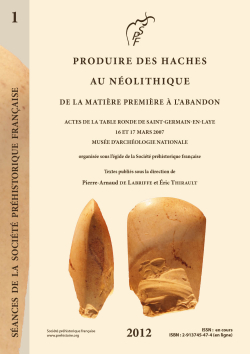
S1-01PDF -La production doutils de pierre en Italie du Nord vue depuis latelier de Rivanazzano (province de Pavie, Lombardie) : matières premières et chaîne opératoire - Claudio DAmico et Elisabetta Starnini
Résumé : Le site-atelier de Rivanazzano est situé sur une grande terrasse fluviatile en rive gauche du torrent Staffora, dans l'Oltrepo de la région de Pavie. La collection d'objets de Rivanazzano provient d'une riche récolte de surface effectuée au nord-ouest de l'habitat actuel, objets répartis sur une surface assez étendue au lieu dit La Cascinetta. Le corpus recueilli se compose actuellement de plus de 700 objets, dont 400 examinés en détail ainsi que 182 échantillonnés et étudiés en pétrographie. L'ensemble est constitué exclusivement d'objets en cours de façonnage et des déchets correspondants, à l'exception d'un tranchant poli de hache brisée. Il s'agit d'ébauches à divers stades de transformation, d'éclats et de percuteurs à attribuer, sur la base de la présence de nombreuses ébauches de ciseaux typiques de la phase initiale de la Culture des Vases à Bouche Carrée, à une activité d'atelier datant probablement du Néolithique moyen, sans que soit exclue la possibilité d'une exploitation antérieure. Cependant, la nature du site de production de Rivanazzano n'est pas discutable à cause de la typologie particulière des objets découverts, tous attribuables à différents stades de la chaîne opératoire d'obtention de lames polies et de haches-herminettes, dont il est possible de reconstruire la séquence complète depuis les galets alluviaux. Dans ce cas particulier en effet, la nature de la matière première utilisée au départ pour le façonnage des lames de hache, hachettes et ciseaux ne peut en aucun cas être mise en doute : il s'agit de galets alluviaux récoltés sur place. Du point de vue pétrographique, la collection de Rivanazzano se présente comme un unicum dans le panorama de l?uro;?Italie septentrionale : à côté des lithotypes communs du métamorphisme de haute pression (HP : jade, éclogite) se retrouve une grande quantité de roches à glaucophane (23 %). Cette association n'est pas plus complexe que celle de nombreux sites du Néolithique moyen, en particulier de sites implantés à l'est de Rivanazzano, qui présentent toujours quelques objets en roches à glaucophane et en schistes omphacitiques, en plus de la nette prépondérance des éclogites par rapport au jade. Mais ce spectre est nettement différent de la situation du Néolithique ancien et de celui que présentent les échantillonnages effectués sur les affleurements alpins et récemment examinés en pétrographie.
Abstract: The workshop site of Rivanazzano is located on a large alluvial terrace on the left bank of the Staffora stream, in the Oltrepo Pavese (south-western Lombardy). The Rivanazzano polished stone assemblage is composed of more than 700 artefacts collected from the surface in locality La Cascinetta, north-west of the present village. 400 specimens have been studied in detail, and 182 submitted to petro-archaeometric analysis. The assemblage is entirely composed of unfinished artefacts (axe/adze blades, chisels) at different stages of manufacture, and wasted pieces, except for a few polished cutting-edged fragments. On the basis of the presence of chisels rough-outs, typical of the initial phases of the Square Mouthed Pottery Culture, the assemblage is to be referred to a workshop for the production of cutting-edged tools attributable to the Middle Neolithic, which, however, does not exclude the possibility of an earlier frequentation of the area. The productive character of the site cannot be disputed due to the typology of the artefacts, which result from different stages of polished stone axes/adzes/chisels manufacture, from which the complete sequence of the "chaîne opératoire" can be reconstructed, from river pebbles onwards. In this specific case the nature of the raw material exploited for the production of the polished stone tools is obvious: river pebbles collected in the neighbouring riverbed, which, in the Staffora Valley, incises the Oligocene formations enriched in metamorphic greenstones. From a petrographic point of view, the Rivanazzano collection represents an unicum in Northern Italy: together with the commonest High Pressure lithotypes (jades, eclogites) it is characterised by the presence of a large number of glaucophane rocks (23 %). This association differs from those of the Neolithic settlements located to the East of Rivanazzano, which always include only a few artefacts made from glaucophane rocks and omphacite schists, and a larger quantity of eclogites and jades. However, the Rivanazzano raw material association is absolutely different from those of the Early Neolithic assemblages so far analysed, and from the petrographic data obtained from recent analyses of raw material samples from Alpine primary outcrops.
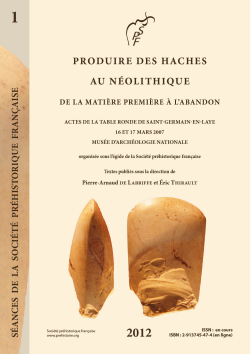
S1-02PDF - Une production domestique de haches au Néolithique moyen Les métabasaltes de Champ-Villars (Saône-et-Loire) - Éric Thirault, Jean Duriaud, Mathieu Rué, Véronique Gardien et Christophe Lecuyer
Résumé : Depuis 1975, des prospections systématiques sur le site de Champ-Villars, en bord de Saône, livrent un mobilier important du Néolithique moyen I. Parmi ces artefacts, 321 fragments et objets entiers constituent une série unique en Bourgogne pour comprendre les processus de production de lames de hache en pierre polie. Les matériaux préférentiels sont des métabasaltes vert-noir à l'état frais, dont les analyses géochimiques tendent à montrer une provenance dans le complexe de la Brévenne, à une cinquantaine de kilomètres au sud du site. Toutes les étapes de fabrication sont attestées sur le site, mais une analyse technologique des artefacts montre que divers processus opératoires sont en oeuvre, et que tous ne sont pas complets. Ainsi, dix types de support ont été identifiés (naturel, sur éclat cortical ou entièrement débité, avec des formats différents), mais les formes obtenues au final ne sont pas liées directement au type de support. Ainsi, nous proposons l'hypothèse d'approvisionnements à une source géologique unique, mais selon des procédés divers : acquisition de supports débités (sur gîte ou sur d'autres sites), de blocs à débiter et de supports naturellement préformés. Ces derniers posent question, car le façonnage de lames polies à partir d'un support naturel est exceptionnel dans le Néolithique. La question du statut de ces diverses productions sur un même site est donc ouvert.
Abstract: Since 1975, systematic survey of the Champ-Villars site, close to the Saône, delivered an important number of artifacts dating from the Middle Neolithic stage 1. Among these, 321 intact and fragmentary objects form a unique series for the understanding of polished stone axe blade production processes in Burgundy. The preferential materials are greenish-black metabasalts. According to geochemical analysis, these tenacious stones would come from the Brévenne complex, about 50 km southward the site. All the fabrication stages can be found at the site, but the technological analysis of the artifacts demonstrates that different operational processes are used, and that all of these are not complete. Thus, 10 types of blanks have been identified (natural, cortical or production flakes, in different sizes), but a link between the type of blank and the finished object's shape is not systematic. So we suggest that the material was collected at a unique geological source following different processes : acquiring knapped blanks (at the source or on other sites), cores and naturally pre-shaped flakes. The last raise question, since the shaping of polished blades from a natural blank remains exceptionnal during the Neolithic. The question of the status of these different procurements on the same site is raised (traduction : Alexis Taylor).
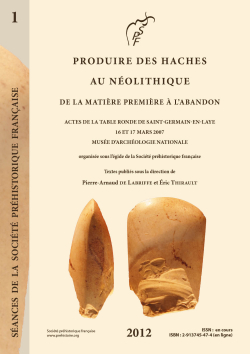
S1-03PDF - Hauterive-Champréveyres (lac de Neuchâtel, Suisse) Les haches en pierre polie Acquisition de la matière première et organisation spatiale, lapport des déchets de fabrication Catherine Joye
Résumé : Le village Cortailllod classique d'Hauterive-Champréveyres se trouve sur la rive nord du lac de Neuchâtel. C'est lors d'une intervention de sauvetage liée au passage de l'autoroute A5, à l'est de la ville, qu'il a été mis au jour, puis fouillé sur la totalité de son extension. Cette agglomération, qui n'a connu qu'une phase d'occupation (3810 à 3794 av. J.-C.), comprenait des habitations et des annexes, ceintes par deux palissades. Le fait que le mobilier ait été peu remanié après l'abandon du village a permis d'en effectuer une analyse spatiale. Dans son ensemble, ce village est particulièrement représentatif du Néolithique moyen des lacs subjurassiens. L'outillage en pierre polie comprend 288 objets et plusieurs centaines d'éclats de façonnage. Les matières premières utilisées sont essentiellement des roches alpines, bien connues dans les apports glaciaires de la région, mais des importations vosgiennes (roches noires) ou, plus rarement, des Alpes italiennes (jadéitite) sont également attestées. Pour les roches locales, la présence des témoins de toute la chaîne opératoire pouvait indiquer que la fabrication s'est toujours intégralement déroulée dans le village une première lecture que la détermination pétrographique des éclats bruts et l'examen de leurs caractéristiques a permis d'affiner. Les éclats provenant d'un même galet ont pu être rassemblés, permettant d'identifier 170 individus au moins. Les lacunes relevées dans ces séries suggèrent deux scénarios d'acquisition : d'une part, récolte de galets à proximité de l'agglomération, d'autre part, prospection à plus grande distance, suivie d'une première mise en forme des pièces sur place. Dans le village même, la distribution des individus confirme une fabrication par unité domestique. L'image des comportements néolithiques se trouve ainsi notablement enrichie par ces résultats.
Abstract: The Classic Cortaillod village of Hauterive-Champréveyres is situated on the North shore of Lake Neuchâtel. It was during rescue digs in connection with the construction of the A5 motorway, to the East of the town, that it was brought to light and subsequently excavated in its entirety. This village, which only knew one occupational phase (3810-3794 B.C.), was made up of houses and annexes, enclosed within two palisades. Due to the fact that the remains were only slightly disturbed subsequent to its abandonment, it was possible to undertake their spatial analysis. Overall, this village is particularly representative of the Middle Neolithic of the lakes at the foot of the Jurassic range. The polished stone tools assemblage comprises 288 objects as well as several hundred stone flakes. The raw material is for the most part made up of Alpine rocks, well known in the glacier-born deposits of the region, although imports from the Vosges (black stones) or more rarely from the Italian Alps (jadeitite) are equally attested. As far as the local rocks are concerned, the remains from the entire chaîne opératoire on the site lent credence to the hypothesis that the entire manufacturing process took place in the village a first interpretation fine-tuned by the petrographic analyses of the rough flakes and the examination of their characteristics. The flakes were sorted, and this led to the identification of at least 170 individual pebbles. The shortfall brought to light suggests two different acquisition scenarios: On the one hand, local stones were collected close by, and on the other, prospecting took place further afield, when the preform was roughed out on the spot. Within the village, the distribution on individual pieces confirms that manufacturing took place at the household level. Our understanding of Neolithic behaviour is thus notably enriched by these findings (traduction : Michael Templer).
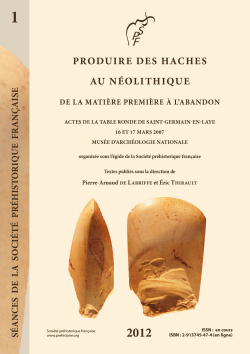
S1-04PDF - La minière-atelier de la carrière Lafarge, La Couronne (Charente) - Pierrick Fouéré et Christophe Fourloubey avec la collaboration de Pascal Bertran, Frédéric Grigoletto et Serge Vigier
Résumé : Connues depuis la fin du xixe siècle pour avoir produit de nombreuses haches en silex, les minières de la région sud d'Angoulême n'ont pourtant guère retenu l'attention des chercheurs actuels. L'intervention récente sur l'exploitation des carrières Lafarge présentée ici permet de rappeler l'importance de cette région dans les réseaux d'approvisionnement en lames de haches. La fouille partielle du site apporte des données sur l'extension de la minière, les modes d'extraction et la matière première utilisée. Une première approche technologique du façonnage des préformes a pu être réalisée devant répondre à la contrainte d'une matière première souvent médiocre.
Abstract: The mines of the region located south of Angoulème have been known for flint axe production since the late nineteenth century. Nevertheless, current research pays little attention to these sites. The results of recent rescue excavation in advance of a Lafarge quarry are presented here, recalling the importance of this area in the supply network for axe blades. The part of the site investigated provides new data on the extent of the mine, extraction techniques and the raw material exploited. Preliminary technical approach of axe roughouts shaping has been made, helping to understand constraint induced by a poor raw material.
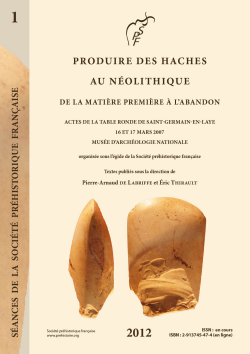
S1-05PDF - Un dépôt débauches de haches à Fontaine-la-Gaillarde (Yonne) - Daniel Buthod-Ruffier, Jacques Pelegrin et Pierre-Arnaud de Labriffe
Résumé : Un dépôt de huit ébauches de haches a été découvert à Fontaine-la-Gaillarde, près de Sens (Yonne), à proximité du complexe de minières du pays d'Othe récemment reconnu lors de fouilles préventives. Ces huit pièces sont dans un état avancé de façonnage mais leurs tranchants restent à achever avant polissage. La qualité de leur façonnage montre un savoir-faire moyen à bon, qui s'accorde au mieux avec l'activité d'un petit groupe de tailleurs moyennement spécialisés, de rang intra-communautaire. Ceux-ci viendraient chaque année de leur village voisin, comme d'autres groupes, pour extraire du silex sur l'une de ces minières et en tirer des ébauches de haches à rapporter pour leur communauté. Cette interprétation est cohérente avec les observations tirées de plusieurs de ces minières du pays d'Othe.
Abstract: A cache of eight flint axe rough-outs was discovered in Fontaine-la-Gaillarde, near Sens (Yonne), not far from the flint mining complex of the pays d'Othe recently recognized during preventive excavations. These eight pieces are in an advanced state of preforming but their cutting edge remain to be shaped out before grinding. The quality of their shaping shows average to good skill, consistent at best with the activity of a small group of moderately trained flint knappers, intra-community rank. They would come every year from their neighbouring village, as other groups, to extract the flint on one of these mining fields and prepare a load of axes roughouts to bring back for their community. This interpretation is consistent with the archaeological observations from several of the mines and related work-shops of the pays d'Othe
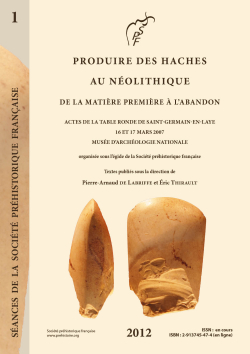
S1-06PDF - Observations sur la taille et le polissage de haches en silex - Jacques Pelegrin
Résumé : La taille et surtout le polissage des haches en silex ont été encore peu étudiés. Loin de prétendre à des généralités ou à une synthèse, cet article présente les résultats de l'observation minutieuse de quelques pièces archéologiques de la Somme et de l'Yonne, dans un but méthodologique. Éclairées pour partie par des tests expérimentaux, ces observations permettent d'abord de préciser les stigmates de l'emploi de la percussion indirecte et de la pression pour la finition du façonnage, à côté de la percussion directe classiquement décrite. L'étude des stigmates de polissage, ensuite, conduit à la détection de différentes techniques dont celle de l'emploi d'un dispositif en « galère » ou « passe-partout » agi par deux individus en va-et-vient, identifiable sur une part des produits eux-mêmes comme sur certains polissoirs. Des données expérimentales quantitatives fixent des ordres de grandeur quant à la durée du polissage de haches selon leur qualité de taille. L'examen de tranchants révèle encore deux techniques d'affûtage du fil, dont les modalités pratiques restent à préciser, et les stigmates de ravivages maladroits. De telles observations peuvent aider à mieux percevoir l'état et l'histoire technique de haches polies néolithiques, et parfois certains aspects socio-économiques voire culturels.
Abstract: The knapping and particularly the grinding of neolithic flint axes deserve more technological investigation. Far from an archaeological synthesis on the matter, this article aims at a methodological level, through the close examination of a few archaeological specimen. Based on some experiments, our observations allow for the identification of the indirect ("punch") percussion technique, and of the pressure technique for the finishing of the cutting edge ready to be polished, besides the classical soft direct percussion technique used for most of the shaping of the axe preform. The examination of grinding features helps to detect different techniques of grinding, one of them consisting in a device acted as a cross-cut saw by two workers, the use of which can be identified both on some polished axes and on particular grinding stones. Experimental quantitative data provide timing estimations about the grinding of axes of different knapping quality. The study and macroscopic documentation of archaeological axe cutting edges (thanks to H. Plisson), shows evidence of two different techniques of edge sharpening, the practical details of which remain to be investigated, as well as a more crude technique of resharpening. A better reading of the "technical state" and "technical history" of Neolithic flint axes, from such technological analysis, may be of socio-economical and cultural interest.
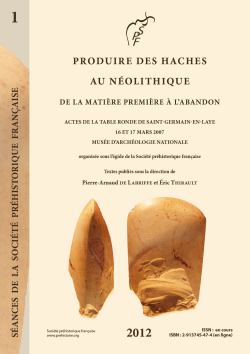
S1-07PDF - Les plaquettes de sciage en pierre dans le Néolithique nord-alpin - Christophe Croutsch
Résumé : En Europe occidentale, la technique du sciage est connue dans divers contextes chronologiques et culturels. Mais c'est probablement au nord des Alpes que cette technique de fabrication des lames de hache et d'herminette est la mieux documentée, comme l'attestent les milliers d'artefacts rejetés ou abandonnés découverts sur des sites littoraux des bords de lac et de tourbière. Dans cette région, il est également possible d'étudier les modalités du sciage puisque l'on connaît les outils utilisés pour le rainurage. Sur le Plateau suisse, l'utilisation des plaquettes de sciage est attestée dès la fin du Ve millénaire av. J.-C. Mais ce n'est qu'à partir de la deuxième moitié du IVe millénaire av. J.-C. que ces objets apparaissent en nombre. Pendant le Néolithique final, la situation reste contrastée avec d'un côté des régions où ce type d'objet fait entièrement défaut, et d'autres où ils sont relativement courant. Ces disparités régionales sont probablement en rapport avec les formes d'exploitation et l'apparition de spécialisations régionales. A travers plusieurs études de cas, cet article présente un outil encore largement méconnu.
Abstract: The technique of sawing is known from a variety of chronological and cultural contexts in western Europe. But it is just north of the Alps that this technique of manufacturing axe and adze blades is probably the best documented, as is reflected by the thousands of discarded or abandoned artefacts found on sites alongside lakes and peat bogs. In this region it is also possible to study how the sawing was done, since the tools used for grooving are known. On the Swiss Plateau, use of sawing stones (plaquettes de sciage) is recorded from the end of the 5th millennium BC. Yet it is only from the second half of the 4th millennium BC that these objects become numerous. During the late Neolithic, the situation remains varied, since there are regions with no objects and others where they are relatively frequent. These regional differences are probably related to forms of exploitation and the emergence of regional specialisations. Through a number of case studies, this article presents a tool that is still largely unknown (Traduction : Michael Ilett).
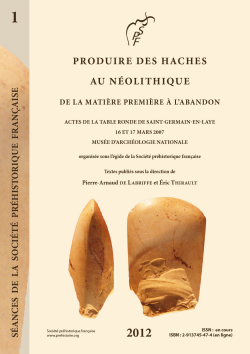
S1-08PDF - La fibrolite, un matériau pour façonner des haches, mais encore ? Le travail de la fibrolite au Néolithique dans lOuest de la France - Yvan Pailler
Résumé : Dès les premières études qui lui furent consacrées par P.-R. Giot et J. Cogné, la fibrolite fut présentée comme un matériau à usage local mais la révision du matériel découvert en Bretagne comme en dehors oblige à revoir sensiblement ce constat. Localement, à l'échelle du Nord du Finistère où d'importants gisements exploités ont été repérés, la cartographie du matériel poli permet d'esquisser des aires de distribution précises. A travers l'examen des contextes de découverte, nous tacherons également de jeter les bases d'une première typo-chronologie des productions en fibrolite. æeuro; la différence d'une roche comme la métadolérite de type A, la fibrolite semble avoir un statut particulier qui va au-delà de son utilisation pour réaliser des outils. Cet aspect est perceptible à travers l'étude des ateliers, des lieux de découverte de certains types d'objets mais aussi de la chaîne opératoire de fabrication des grandes haches à talon pointu.
Abstract: Since the first studies made by P.-R. Giot and J. Cogné, fibrolite was considered as a raw material for local use, but the review of the archaeological material discovered in Brittany and elsewhere forces us to significantly revise this assumption. Locally, across northern Finistère, where large exploited deposits were discovered, the mapping of polished equipment allows us to outline the specific areas of distribution. Through the examination of the contexts of discovery, we will also try to build an initial typo-chronology of the productions made of fibrolite. Unlike a rock like metadolerite of type A, fibrolite seems to have a special status that goes beyond its use in tool production. This becomes evident through the study of the workshops, the places of discovery of certain types of objects, but also in the operational sequence of the production of large pointed-butt axes.
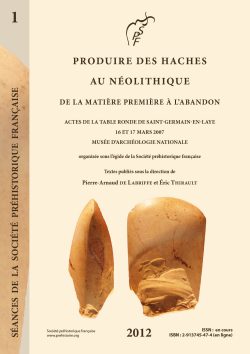
S1-09PDF - La production de haches à Spiennes : un état de la question - Hélène Collet
Résumé : Le façonnage de lames de hache est attesté de 4400/4200 à 2900/2700 BC, tout au long de la période d'exploitation du site minier de Spiennes et est un des produits principaux issu de ces ateliers. Cet article fait le point sur l'état des connaissances sur cette production en abordant la sélection de la matière première, les types de support utilisés, les méthodes de façonnage, les éléments de la chaîne opératoire présents sur le site ainsi que la morphologie et les dimensions des lames de hache réalisées.
Abstract: The flint-mining complex of Spiennes has been dedicated to the production of axe blades during its whole existence, from 4400/4200 to 2900/2700 BC. This paper offers a review of the state of knowledge over this production and tackles the miners selection of the raw material, the blank's types, the processing methods and the "chaîne opératoire" elements as observed on the field, as well as the typical morphology of its products.
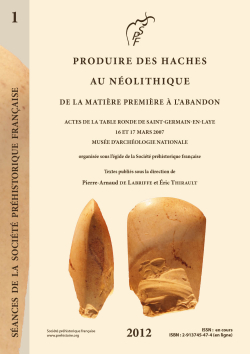
S1-10PDF - Produire des haches en silex dans le Sud-Est du Bassin parisien au Néolithique Les minières à silex de lautoroute A5 - Anne Augereau
Résumé : L'étude de la production de haches en contexte minier a fait un progrès important durant les années 1990, notamment à travers le suivi archéologique des grands travaux tel celui de l'autoroute A5. Dans cette région du Sud-Est du Bassin parisien très riche en silex, plusieurs sites d'extraction et de production minière ont pu être documentés de manière précise. Ainsi, la chaîne opératoire de production des haches peut être caractérisée : la qualité médiocre de la matière première conditionne un système d'exploitation aléatoire et des produits finis courts et peu standardisés, fabriqués par des tailleurs de compétence et d'expérience variable. Ces données, associées à l'abondance des sites d'extraction dans la plupart des vallées voisines occupées au Néolithique permettent d'affirmer que les minières de l'autoroute A5 témoignent d'une exploitation casuelle des gisements de silex satisfaisant aux besoins locaux.
Abstract: The study of axe production in mining context has made important progress during the 90s, notably through preventive archaeological operations such as the A5 motorway, in the southeast of the Paris basin. This region is a very rich flint area and several mining production sites were dug and studied to be documented accurately. Thus, the axes production can be characterized : the poor quality of the raw material determines a random exploitation system and the finished products are short and little standardized ; probably, they were manufactured by knappers with variable experiences. These data, associated with the abundance of mining sites in most neighbouring valleys occupied in Neolithic times, allow us to say that the mining sites of the motorway A5 reflected a random exploitation of the flint deposits to meet local needs.
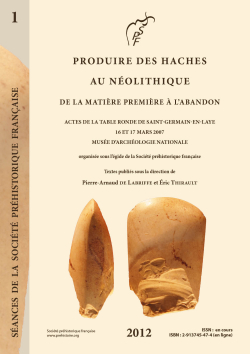
S1-11PDF - La production de haches dans lOuest de lÎle-de-France (Yvelines, Val-dOise) Approche typo-technologique et spatiale - Françoise Bostyn, Jérémie Couderc, François Giligny, Harold Lethrosne, Nicolas Le Maux, Adrienne Lo Carmine et Cécile R
Résumé : Cet article présente les premiers résultats d'une recherche concernant l'étude des productions de haches dans le cadre d?uro;?un programme de recherches plus large sur l'évolution de l'implantation des populations néolithiques dans les départements des Yvelines et du Val-d'Oise. Au travers des données issues des sites de production (minière et ateliers), les chaînes opératoires de fabrication des haches sont précisées pour chaque matière première (Bartonien, Crétacé, grès-quartzite). Le recensement des haches taillées et polies dans les collections de surface, associé à une cartographie des lieux de découvertes, débouche sur une étude de la diffusion des produits en fonction des étapes de la chaîne opératoire. L'élargissement de la recherche aux régions plus occidentales (Normandie) permet de proposer des premières hypothèses sur les réseaux de circulation des lames de haches sur de longues distances.
Abstract: This paper presents the first results of a research concerning the flint and stone axes production, which is one of the topic of a largest program about the history of the neolithic settlement of the Yvelines and Val-d'Oise department. The study of the production sites (flint mine and workshop) allows to describe the "chaîne opératoire" of axe production for each raw material (bartonian flint, cretaceous flint, sandstone/quartzite). The review of the flaked and polished axes coming from the surface survey and the cartography of these discoveries open on the study of the distribution of the axes at the different stages of production. Enlarging the program to the western part of the Paris basin, it's possible, at that time, to discuss about the long distances exchanges.
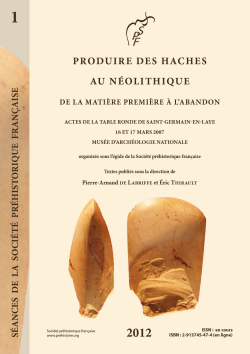
S1-12PDF - Habitat et site dextraction de silex au début du Néolithique moyen Les sites de la Croix-Sainte-Anne à Juigné-sur-Sarthe et du Camp de César à Vion (Sarthe) - Emmanuel Georges et Gwenolé Kerdivel avec la collaboration de Jean-Noël Guyodo, Gwen
Résumé : L'habitat de la Croix-Sainte-Anne à Juigné-sur-Sarthe et le site d'extraction de silex du Camp de César à Vion (Sarthe) sont connus depuis la fin du xixe siècle par des ramassages de surface. Distants de 4,1 km, ils se placent de part et d'autre de la limite géologique du Massif ancien armoricain et du Bassin parisien. En 2006, une opération de sondages archéologiques a permis de mieux caractériser les deux sites et d'étudier leurs relations. Ainsi Vion est une minière qui permet l'extraction d'un silex bien reconnaissable. C'est aussi un atelier de taille de lames de haches où toutes les phases de fabrication sont présentes du bloc de matière première jusqu'à la préforme prête à polir. Le silex découvert à Juigné-sur-Sarthe provient à 95 % du site de Vion. Les lames de haches arrivent sur l'habitat prêtes à polir contrairement au reste du mobilier lithique qui est façonné sur place. Autour des sites étudiés, deux polissoirs et trois sites mégalithiques forment une concentration et une diversité d'occupation rare dans la région. Les éléments chronologiques recueillis renvoient au début du Néolithique moyen.
Abstract: The settlement of "Croix Sainte-Anne" in Juigné-sur-Sarthe and the flint-mine of "Camp de César" in Vion (Department of Sarthe, France) have been know since the end of 19th century by many field survey. Distant from 4,1 km, they are sitting on the bound of Armorican massif and Parisian basin. During the year of 2006, two archaeological excavations had allowed to understand better these settlements and study those connections. Vion is a flint-mine that supplies one easily recognising flint. Also, it is an axes knapping settlement, where all making-levels are known: from the flint block to the knapping axe. In Juigné-sur-Sarthe, the flint supplying consists of 95 per cent of Vion's flint. The tools are made on the place, except the knapping axes, that are arriving here start to polish. All along these studied settlements, two polishers and four megaliths make a cluster. Theses sites are dating from the beginning of Middle Neolithic.
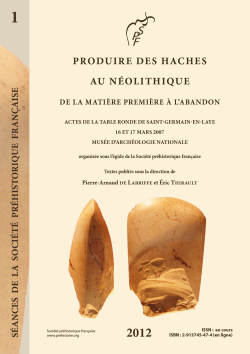
S1-13PDF - Les haches de pierre polie du Néolithique dans le Languedoc, la zone nord-orientale des Pyrénées et la marge sud-ouest du Massif central Jean Vaquer, Christian Servelle et François Briois avec la collaboration de Maxime Remicourt
Résumé : Les industries en pierre polie du Néolithique de cette zone du Sud de la France n'ont fait l'objet jusqu'à présent que d'approches partielles. Si la zone méditerranéenne a bénéficié d'une synthèse (Ricq de Bouard, 1996), la zone océanique n'a fait l'objet que d'études ponctuelles limitées à quelques aspects des productions et des diffusions. Nous proposons dans cette étude d'examiner ces outillages en mêlant les informations provenant de ces deux régions. Il est évident en effet que les territoires situés de part et d'autre de la ligne de partage des eaux ont été en interaction forte tout au long du Néolithique et qu'ils ont même été le plus souvent intégrés à des dynamiques culturelles communes. C'est à partir d'examens de multiples et abondantes séries de haches polies et de prospections en contexte alluvial ou sur les gîtes géologiques que la question des productions régionales est abordée et renouvelée. Il apparaît que la recherche de roches tenaces a dû débuter par l'exploitation de galets qui est attestée partout et que certaines d'entre-elles ont ensuite été exploitées en gîtes. Dans la partie est des Pyrénées la sélection a porté sur des roches ultrabasiques dont les gisements très localisés se trouvent en Haute-Ariège. Dans la vallée de la Garonne ce sont des roches métamorphiques banales qui ont été utilisées essentiellement sous forme de galets. Dans le bassin du Tarn se sont des roches volcaniques qui ont été sélectionnées, certaines ont donné lieu à d'importantes exploitations et ateliers comme les cinérites volcano-sédimentaires de Réquista en Aveyron ou les métabasites de l'Albigeois cristallin et des monts de Lacaune. L'ampleur de la diffusion des productions régionales n'est pas encore bien connue. Elle paraît assez limitée pour la cinérite de Réquista qui est attestée ponctuellement en Catalogne et en Rhône-Alpes et qui n'a eu de réelle importance qu'en Auvergne. Il est probable que les amphibolites calciques nord pyrénéennes ont joué un rôle en Catalogne où elles abondent dans les offrandes funéraires des sepulcros de fosa mais la caractérisation des diverses variétés de cette roche et des sources correspondantes reste encore à préciser. Les roches exogènes parvenues dans la région sous forme d'importations de produits finis n'ont pas été négligées dans cette enquête. C'est ainsi que les importations de haches alpines de travail ou d'apparat ont fait l'objet de nouveaux recensements qui précisent leur répartition et leurs contextes. Ces inventaires ont concerné aussi d'autres productions comme celles en fibrolite ou sillimanite qui témoignent de réseaux provenant du Massif central ou celles en silex grenu ou en silex meulière qui proviennent de l'Aquitaine. La situation géographique de la région peut en partie expliquer ce jeu de concurrences entre les productions locales et les importations d'origine alpine ou du Centre-Ouest de la France. Toutefois il convient tout d'abord de préciser que la chronologie des productions locales perçue sur les sites récepteurs révèle quelques exploitations de très longue durée tandis que d'autres n'ont eu lieu qu'au Néolithique récent et final. Les évolutions des divers réseaux de diffusion ne sont perceptibles que très partiellement. Pour chaque étape les situations de compétition qui sont observées entre les réseaux locaux et les apports exogènes impliquent l'existence d'échelles de valeur dont la restitution nécessite une prise en compte de multiples aspects. Il s'agit des densités d'occurrences ou des variations de fréquences relatives dans les séries d'outillages d'habitats mais aussi des sélections opérées pour les offrandes funéraires ou pour les dépôts.
Abstract: In this part of the South of France, the ground stone industries of the Neolithic were the object until now only of partial approaches. If the mediterranean zone benefited from a synthesis (Ricq de Bouard, 1996), the oceanic zone made the object only of punctual studies limited to some aspects of the productions and the diffusions. We suggest in this study examining these tool kit by combining the information from these two regions. It is evident indeed that territories located on both sides by the watershed were in strong interaction throughout the Neolithic and that they were integrated even mostly into common cultural dynamics. It is from examinations of multiple and plentiful collection of polished axes and prospectings in alluvial context or on the geologic deposits that the question of the regional productions is approached and renewed. It seems that the search for hard rocks had to begin with the exploitation of pebbles which is attested everywhere and that some of them were then exploited in deposits. In the East from Pyrenees the selection concerned ultramafic rocks which deposits are very localized in the Haute-Ariège. In the Garonne valley, it is place of the metamorphic rocks which were essentially exploited in the form of pebbles. In the Tarn basin these are volcanic rocks which were selected, some leaded to important exploitations and workshops as the volcano-sedimentary cinerite of Réquista in Aveyron or the metabasit rocks of Albigeois and the crystalline rocks of Lacaune Monts. The extent of the distribution from the regional productions is not still well known. It seems limited enough for the Réquista cinerite that is punctually attested in Catalonia and in Rhône-Alpes and that had real importance only in Auvergne. It is likely that the Pyrenean north calcic amphibolte used in Catalonia where they abound in the sepulcros de fosa funeral offerings, but the characterization of the diverse varieties of this rock and the corresponding deposits still remains to clarify. The exogenetic rocks reached in the region in the form of imports of finished products were not neglected in this investigation. And so the imports of work or ceremonial alpine axes were the object of new inventories which clarify their distribution and theirs contexts. These inventories also concerned the other productions as those fibrolite or sillimanite that shows of distribution systems from the Massif Central or those in granular flint or in millstone grit from Aquitaine. The geographical situation of the region can partially explain there competitions between the local productions and the imports of alpine origin or Centre-Ouest of France. However the chronology of the local productions perceived on the receiving sites reveals some exploitations of very long lenght whereas some others only in the Recent and Final Neolithic. The evolutions of the diverse distribution systems are perceptible only very partially. For every stage the situations of competition which are observed between the local distribution systems and the exogenous contributions imply the existence of values scales which the reconstruction requires a consideration of multiple aspects. It is about occurrence densities or about variations of relative frequencies in the tool kit series on the dwelling site but also the selections reflected for the funeral offerings or for the hoard.
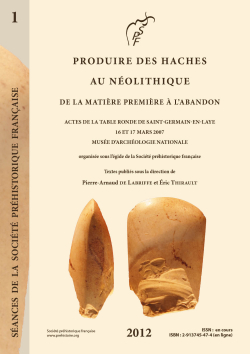
S1-14PDF - Une imitation de hache alpine type Bégude à Buthiers-Boulancourt (Seine-et-Marne) au début du Ve millénaire Anaïck Samzun, Pierre Pétrequin et Estelle Gauthier
Résumé : Une hache en schiste métamorphique et un long pic en silex ont été découverts dans une sépulture à inhumation, datée de 4906-4709 av. J.-C. Par son contexte culturel et la date radiocarbone, cette sépulture a été attribuée au Villeneuve-Saint-Germain. L?uro;étude typologique de la hache permet de suggérer qu?uro;il s?uro;agit d?uro;une imitation, en roche non alpine, d?uro;une longue hache polie de type Bégude, dont les centres de production sont situés autour du mont Viso et du mont Beigua dans les Alpes italiennes, à environ 500 km à vol d?uro;oiseau. La révision chronologique des haches en roches alpines montre que les premières importations dans le Bassin parisien et la France de l?uro;Est remontent justement au tout début du Ve millénaire. Ces haches de type Bégude, des outils classiques de travail en Italie du Nord, ont été socialement réinterprétées au-delà des Alpes, valorisées et affectées au domaine des dieux ou bien utilisées pour afficher la suprématie de certains hommes. L?uro;impact de ces objets de pouvoir a été si important que des productions régionales en grès de Fontainebleau ou en pélite-quartz des Vosges en ont été faites avant le milieu du Ve millénaire. La hache de Buthiers- Boulancourt est donc un des témoins les plus anciens des conséquences de la circulation des prestigieuses productions alpines, contemporaines du groupe de Fiorano et de ses épigones, à l?uro;origine de la mode des anneaux disques dans le Villeneuve-Saint-Germain et des premières exploitations de roches locales pour la fabrication de lames polies de travail du bois, à l?uro;imitation des grandes haches exotiques.
Abstract : An axehead of schistose pelite and a long flint pick were discovered in an inhumation grave dated to 4906?uro;4709 cal BC. From its cultural context and its radiocarbon date, this grave has been assigned to the Villeneuve-Saint-Germain culture. The typological study of this axehead allows us to suggest that it was an imitation, in a non-Alpine rock, of a long polished axehead of Bégude type, whose centres of production are situated around Mont Viso and Mont Beigua in the Italian Alps, around 500 kilometres away as the crow flies. The revision of the chronology of Alpine rock axeheads has revealed that their very earliest importation into the Paris Basin and eastern France took place at the beginning of the 5th millennium. These axeheads of Bégude type, which in north Italy were used as classic workaday axeheads, were socially reinterpreted beyond the Alps, gaining in value and becoming associated with the realm of the gods, or being used as prestige items to demonstrate the supremacy of certain men. The impact of these symbols was such that it triggered the regional production of axeheads made of Fontainebleau sandstone and of pelite-quartz from the Vosges prior to the midfifth millennium. The axehead from Buthiers-Boulancourt thus seems to offer us one of the earliest pieces of evidence demonstrating the consequences of the circulation of prestigious artefacts from the Alps at the time of the Fiorano culture and its counterparts. This phenomenon ?uro; the circulation of prestigious Alpine artefacts ?uro; can also explain the origin of the fashion for making ring-discs in the Villeneuve-Saint-Germain culture, and the exploitation of local rock types for manufacturing polished stone workaday axeheads that imitated the shape of the large exotic Alpine axeheads.
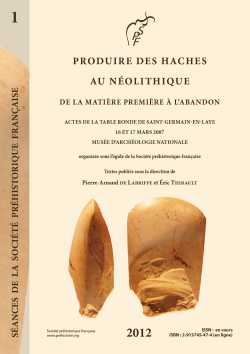
S1-15PDF - Hypothèses sur la circulation et les stratégies dapprovisionnement en « roches vertes » en Italie du Nord à la lumière des associations lithologiques présentes dans les lames de hache Claudio DAmico et Elisabetta Starnini
Traduction par Anna Pallaro
Résumé : Les études archéométriques conduites depuis plus d'une vingtaine d'années ont établi que la lithologie de la pierre polie, en particulier des lames de hache, est caractérisée, sur les sites néolithiques de l'Italie septentrionale, par une prédominance des métaophiolites de haute pression (HP). Ces roches représentent dans de rares cas jusqu'à 100 % de la matière première des objets en pierre polie ; elles atteignent souvent 90 % environ et ne sont jamais inférieures à 65-70 %. Le reste est représenté par des lithologies de non HP-métaophiolites en pourcentage variable de 0 % à environ 30 % (habituellement inférieurs à 10 %) ; ces lithologies sont liées à différentes aires géographiques de découverte. L'idée d'une production prépondérante à partir de blocs détachés et de galets est commune à de nombreux auteurs. Les travaux récents de P. Pétrequin tendent à considérer les affleurements alpins comme les sources prépondérantes, alors que les sources détritiques seraient d'importance secondaire (Pétrequin et al., 2005a et 2006a). La proposition de ce modèle d'approvisionnement en matière première nous a poussé à effectuer un examen des données acquises et publiées dans les années précédentes. Le but est de cerner quelques règles ou tendances qui se feraient jour dans la distribution des associations lithologiques, en rapport avec la chronologie et dans la relation éventuelle entre les sites. Quand on regarde l'association lithologique, des différences significatives sont observées entre sites. Ces différences concernent avant tout une présence nettement variable des jades par rapport aux éclogites, l'absence ou la présence de schistes omphacitiques et de schistes à glaucophane dans les collections, toujours en rapport avec les variations chronologiques et géographiques. Ce constat allant de pair avec l'augmentation de l'échantillon au cours du temps comme avec des vérifications pétrographiques et archéologiques adéquates, il est alors possible en l'état actuel de déduire quelques interprétations sur la circulation et l'approvisionnement lithique durant le Néolithique. Tout particulièrement, la confrontation entre associations lithologiques a permis de faire l'hypothèse, au cours du Néolithique moyen, de l'existence d'un important axe d'approvisionnement en direction des sites localisés à l'est de Rivanazzano. Il semble en revanche qu'on doive exclure une alimentation significative des sites de l'ouest de Rivanazzano. On trouve par ailleurs confirmation d?un approvisionnement par l'intermédiaire de plusieurs axes directeurs pour les sites à occupations multiples d'Alba et de Sammardenchia où la similitude lithologique avec Rivanazzano est minime, même si on ne peut exclure tout à fait un éventuel apport en matières premières à partir de cette aire.
Abstract: Twenty years of research and achaeometric analyses have shown that the lithology of the polished stone tools, in particular axe/adze blades, from the Neolithic sites of northern Italy, is characterized by the predominance of High-Pressure metaophiolites (HP). At some sites, these rocks represent 100% of the raw material utilized for making cutting-edged polished tools, more often 90%, and never less than 65-70%. The other lithotypes are non HP-metaophiolites, in a percentage that varies from 0% to ca 30% (normally less than 10%), according to the local geology of the different sites. The idea of the prevailing exploitation of river pebbles, or collection of raw material pieces from blocks, detached from large cobbles, is commonly accepted by several scholars, and it is demonstrated by the material culture remains from the sites. In contrast to this evidence, recent works by Pétrequin (Pétrequin et al., 2005a and 2006a) have proposed, as a prevailing procurement model, the extraction of raw material directly from the primary outcrops of the Alps, whilst the detritic sources are considered of secondary importance. The question of exploitation of detrital deposits or of primary outcrops may be solved admitting the existence of both strategies, but for the manufacture of different products. This model of raw material procurement has stimulated an articulated analysis of the data so far available, whose scope is to define rules or trends in the distribution patterns of archéothelithological associations according to the chronology and cultural attribution of the sites. The study of the lithological associations shows significant differences among the sites. They consist, first of all, of the variable percentages of jades in relation to eclogites, and
presence/absence of omphacitic and glaucophane schists in the assemblages, according to the chronology of the sites and their geographical
location. In particular, the area of Rivanazzano (PV), where a large workshop for the production of polished stone axes, adzes and chisels was discovered, seems to stand up as a greenstone supplier zone of many Middle Neolithic sites towards the East, according to their litho-typology revealed by petrographic analyses. Other Early Neolithic sites as well as two Middle Neolithic ones, located to the west of Rivanazzano, have less lithological similarity with Rivanazzano and have been probably supplied by other sources. Other assemblages with a less definite lithological character are shortly discussed, in particular Alba (Piedmont) and Sammardenchia (Friuli).
Even though this trend might be validated in the future by an increasing number of archaeometric analyses of adequate samples, it is already possible to try to interpret the network of polished stone tools circulation and raw material procurement during the Neolithic.
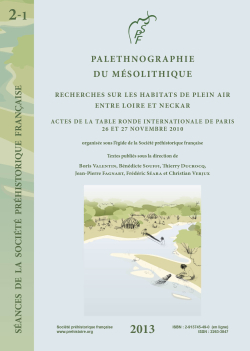
S2-01PDF - Bénédicte Souffi et al. - Occupations mésolithiques en bord de Seine : le site du 62 rue Henry-Farman à Paris (15e arrondissement). Organisation et fonctionnementLe site mésolithique du 62 rue Henry-Farman à Paris (15e arrondissement) est localisé au sud-ouest de la ville, à environ 250 m du lit actuel de la Seine, sur la rive gauche. La fouille réalisée en 2008 sur une surface de 5 000 m² a mis au jour une séquence stratigraphique dorigine fluviatile dans laquelle sont interstratifiés plusieurs niveaux doccupation. Lessentiel de la fouille a porté sur loccupation mésolithique qui a livré six concentrations de vestiges spatialement indépendantes (locus). Daprès les études paléoenvironnementales et typo-technologiques ainsi que deux datations radiométriques, lensemble est attribuable à la chronozone du Boréal voire à la transition Préboréal / Boréal, soit à la phase moyenne du Mésolithique (8000-6900 av. J.-C.). Les différents locus correspondent à des occupations successives caractérisées par au moins trois assemblages typologiques distincts, tous dominés par les pointes à base retouchée (Beuronien). Sur un plan fonctionnel, les locus révèlent des activités variées, axées principalement sur la fabrication darmatures de flèches en silex et impliquant également lemploi doutils domestiques en silex, grès et os.
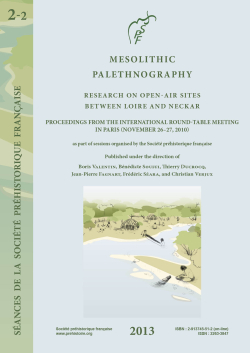
S2-02EN_PDF_Daniel Mordant, Boris Valentin and Jean-Denis Vigne Noyen-sur-Seine, twenty-five years onThis chapter summarises our current understanding of the site of Noyen-sur-Seine by highlighting several particular aspects starting from the field and leading up to perspectives which may be explored in the light of current Mesolithic research. Following a brief history of this groundbreaking research, several successive topics will be addressed: the sedimentary dynamics of the anthropic deposits, the possible origin and differential preservation of the remains (D. M.), previously published information and new perspectives concerning the faunal material (J.-D. V.), lithic industries and human remains (B. V.). This outline should by no means be confused with the presentation of a fixed research program, but rather a call for new research incorporating the many projects that remain to be elaborated or strengthened.
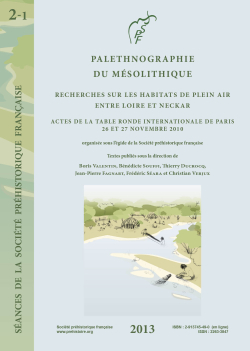
S2-02PDF - Daniel Mordant, Boris Valentin et Jean-Denis Vigne Noyen-sur-Seine, vingt cinq ans aprèsLa présentation faite à loccasion de cette table ronde se propose de dresser, à laide déclairages particuliers, la fiche signalétique du site de Noyen-sur-Seine en 2012, en partant du terrain et en esquissant diverses pistes qui pourraient être suivies dans la perspective des recherches actuelles sur la période. Après un historique des recherches qui furent pionnières dans ce domaine, seront successivement abordées : la dynamique des dépôts sédimentaires anthropisés, lorigine possible des vestiges et leur conservation différentielle (D. M.) ; les informations déjà publiées et les perspectives concernant les ensembles fauniques (J.-D. V.) ; de nouvelles pistes détude des industries, des restes humains (B. V.). Il ne sagit pas, bien entendu, de la présentation dun programme fermé, mais, au contraire, dune incitation à la recherche à partir de projets qui restent, pour beaucoup, à construire ou affermir.
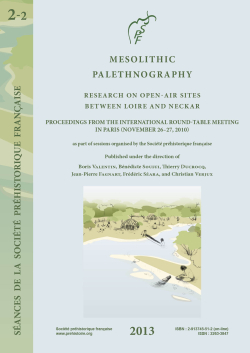
S2-03EN_PDF_Joël Confalonieri and Yann Le Jeune - The Mesolithic site of Haute-Île at Neuilly-sur-Marne (Seine-Saint-Denis): preliminary resultsA Mesolithic site was discovered during an archaeological evaluation of Haute-Île at Neuilly-sur-Marne (Seine-Saint-Denis) carried out by a mixed team from the INRAP and the council of Seine-Saint-Denis. The site is found on the right bank of the Marne River valley at an average altitude of 40 m NGF. This 65 ha area is found some 15 km upstream of Paris in one of the last bends of the Marne and has been designated a departmental park since 2005. The Mesolithic levels identified during a preliminary archaeological diagnostic in 2003 and 2004 lie within a paleosol on the edge of a paleochannel. These well-preserved levels are spread over a surface of a little less than 3 ha of which only 1.5% has so far been excavated. The Mesolithic levels contain abundant lithic artefacts, stone features and a burial. Based on an initial typological study they can be assigned to a succession of Middle and Late Mesolithic occupations fostered by the simultaneous presence of a river ford and open wetland banks creating an ideal location for hunting and setting up camp. The nearby banks of the paleochannel also produced Mesolithic artefacts, while an older level of a seldom-observed Holocene riverbank remains to be investigated. The Mesolithic site of Haute-Île still holds enormous archaeological as well as geoarchaeological potential and will probably be the focus of research in coming years.
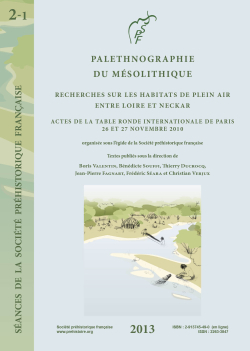
S2-03PDF - Joël Confalonieri et Yann Le Jeune - Le site mésolithique de la Haute-Île à Neuilly-sur-Marne (Seine-Saint-Denis) : premiers résultatsUn site mésolithique a été mis au jour lors de lévaluation archéologique de la Haute-Île à Neuilly-sur-Marne (Seine-Saint-Denis), menée en 2000 par une équipe mixte de lINRAP et du conseil général de la Seine-Saint-Denis. Le site se trouve en fond de vallée sur la rive droite de la Marne à une altitude moyenne de 40 m NGF. La parcelle, dune superficie totale de 65 ha, sinscrit dans une des dernières boucles de la Marne, à environ 15 km en amont de Paris, et elle a été aménagée en parc départemental depuis lannée 2005. Les niveaux mésolithiques identifiés lors du diagnostic archéologique préalable de 2003 à 2004 sont localisés au sein dun paléosol en bordure dun paléochenal. Ils sont bien conservés et structurés sur une surface estimée à un peu moins de trois hectares dont seuls 1,5 % ont été fouillés jusquà présent. Les niveaux mésolithiques se caractérisent par un abondant mobilier lithique, des structures empierrées et une sépulture. Daprès les premières études typologiques sur lindustrie lithique, il sagit dune succession doccupations mésolithiques du Mésolithique moyen au Mésolithique récent favorisée par la présence simultanée dun gué et de rives franches accessibles en zone humide, lieu de chasse et de séjour privilégiés. À proximité, les rives du paléochenal ont également livré des vestiges mésolithiques alors quun niveau de berge holocène plus ancien, jusqualors rarement observé, reste encore à explorer. Le site mésolithique de la Haute-Île recèle encore un très grand potentiel tant archéologique que géoarchéologique et fera probablement lobjet de recherches dans les années à venir.
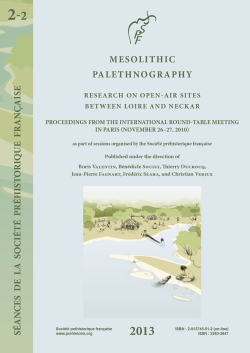
S2-04EN_PDF_Christian Verjux, Bénédicte Souffi, Olivier Roncin, Laurent Lang, Fiona Kildéa, Sandrine Deschamps and Gabriel Chamaux - The Mesolithic of the Centre region: state of researchFollowing a period that essentially focused on the analysis of collections from pedestrian surveys, our understanding of the Mesolithic period in the Centre region has recently been updated, most notably in connection with the growing number of rescue excavations. Although the chrono-cultural framework has been refined, the majority of dates still fall within a short period between around 8200 and 7600 cal BC, i.e. the end of the Preboreal and the onset of the Boreal. The preservation conditions of most excavations have nonetheless rendered palethnographic information rare.
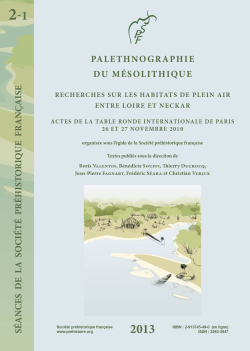
S2-04PDF - Christian Verjux, Bénédicte Souffi, Olivier Roncin, Laurent Lang, Fiona Kildéa, Sandrine Deschamps et Gabriel Chamaux - Le Mésolithique en région Centre : un état des recherchesAprès une période consacrée essentiellement à létude de séries issues de prospections pédestres, la région Centre connaît un renouvellement des connaissances sur la période mésolithique, notamment en liaison avec des opérations darchéologie préventive en nombre croissant. Le cadre chrono-culturel se précise, bien que la majeure partie des données se rapporte actuellement à une courte période située autour de 8200 à 7600 av. J.-C., soit de la fin du Préboréal au début du Boréal. Les informations dordre palethno-graphique demeurent toutefois encore rares, la plupart des fouilles ayant été conduites sur des sites ne présentant pas les conditions de conservation appropriées.
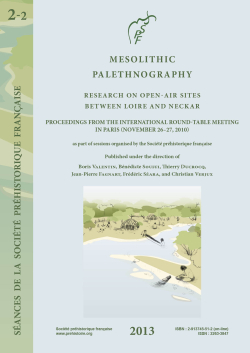
S2-05EN_PDF_Fréderic Séara and Olivier Roncin - Mesolithic valley floor occupations: the case of Dammartin-Marpain in the JuraPreliminary information from the site of Dammartin-Marpain further highlights the key role played by valley floors for the study of prehistoric populations. At Dammartin we note important Mesolithic activity linked to a succession of camps radiocarbon dated to between 8300 and 7200 BC, as well as a Final Mesolithic occupation identified by typological criteria. The intensity of occupation is reflected in the more than 27,000 lithic elements recovered, including 620 microliths, to which can be added used and unused cobbles, occasional bone remains, ochre fragments and hazelnut shells. Beyond these initial assessments, petrographic determinations, a preliminary functional analysis, initial lithic refits, as well as the beginnings of a spatial analysis also reveal interesting perspectives. The overall aspect of the cultural material is clearly Sauveterrian, which to some extent redraws the boundaries of Beuronian techno-complex still considered as the main cultural component of the regional Mesolithic.
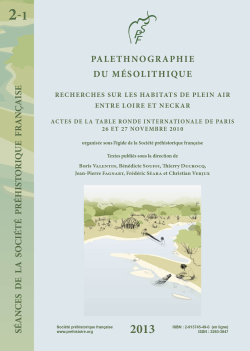
S2-05PDF - Fréderic Séara et Olivier Roncin -Fonds de vallée et fréquentation mésolithique. L'exemple de Dammartin-Marpain dans le JuraLes premières observations sur le site de Dammartin-Marpain soulignent à nouveau le rôle-clé joué par les fonds de vallées dans létude des peuplements anciens. À Dammartin, on constate une fréquentation mésolithique remarquable avec une succession de campements datés par le radiocarbone entre 8300 et 7200 av. J.-C. , et de la fin du Mésolithique sur la base de critères typologiques. Lintensité de loccupation se caractérise par plus de 27 000 éléments lithiques dont 620 armatures microlithiques, auxquels il convient dajouter galets bruts et utilisés, rares restes osseux, fragments docre et coquilles de noisettes. Au-delà de ces premiers constats, les déterminations pétrographiques, létude fonctionnelle préliminaire, les premiers remontages lithiques ainsi quun début danalyse spatiale révèlent des perspectives de premier plan. Toutes ces données sinscrivent dans un cadre culturel nettement sauveterrien, nuançant ainsi lemprise beuronienne que lon considérait encore récemment comme la principale composante culturelle régionale.
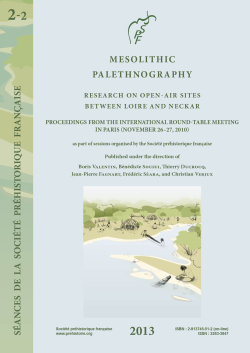
S2-06EN_PDF_Lorène Chesnaux - Microliths from 62 rue Henry-Farman, Paris (15th arrondissement): specific arrows for different types of game hunted in particular places?This chapter presents a functional analysis of Beuronian microliths from the site of 62 rue Henry-Farman in the 15th arrondissement of Paris. The combination of use-wear and experimentation brings to light an unexpected spatio-temporal separation of hunting related activities. Points, just like triangles and crescents, were manufactured on-site and abandoned before being used. Whereas triangles and crescents, employed as barbs or point-barbs, were reintroduced into the assemblage within carcasses, 80% of which were wild boar.
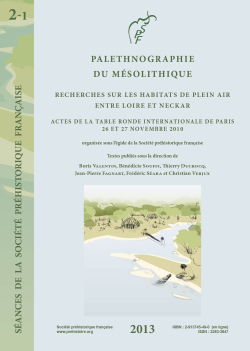
S2-06PDF - Lorène Chesnaux - Les microlithes du 62 rue Henry-Farman à Paris (15e arrondissement) : des flèches diverses pour différents gibiers abattus en des lieux distincts?Cet article est consacré à la caractérisation fonctionnelle, sur une base tracéologique et expérimentale, des microlithes beuroniens du 62 rue Henry-Farman à Paris (15e arrondissement). Cette caractérisation met en évidence une segmentation spatio-temporelle inattendue des activités liées à la chasse. Les pointes, fabriquées sur place à linstar des triangles et segments, ont été abandonnées sur place avant leur utilisation. A contrario, triangles et segments, ayant joué le rôle de barbelures et de pointe-barbelures, ont été réintroduits dans lassemblage au sein des carcasses, appartenant pour 80 % à du sanglier.
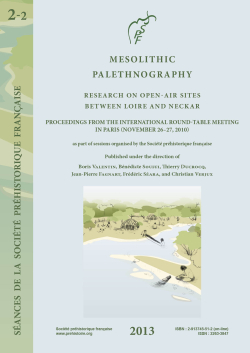
S2-07EN_PDF_Sylvain Griselin, Caroline Hamon and Guy Boulay Manufacture and use of Montmorencian prismatic tools: the case of 62 rue Henry-Farman, Paris (15th arrondissement)The Mesolithic site of 62 rue Henry-Farman in Paris 15th arrondissement, excavated by the INRAP in 2008, has produced a series of prismatic tools whose mode of production, maintenance and use are investigated here. These macrolithic tools are known from numerous Middle Mesolithic sites in and around the Île-de-France and occasionally in the rest of the Paris Basin. At the Paris site, these quartzite tools are generally broken, but can measure up to 10 cm in length when whole. They have triangular and / or trapezoidal cross-sections with a flat un-retouched face characteristic of Montmorencian tools. The shaping of these pieces is relatively simple as it aims to shape-out the sides and the dorsal face, forming the tools lateral longitudinal ridges. Different degrees of repair are observable on the tools, indicating a fairly long period of use. Use-wear referable to contact with a mineral material is visible along the longitudinal ridges of both the flat and opposing faces, while the prominences of the sides show a distinct undetermined type of wear. The ridges seem to constitute the main working surfaces of these objects and, despite some wear on the extremities of several examples, the overall use-wear distribution refutes their supposed main use as picks. Further functional hypotheses may be formulated and several preliminary tests have been carried out to evaluate them, including the use of these tools as retouchers to fracture bladelets using the microburin technique. This hypothesis is discussed in the light of use-wear observed on archaeological and experimental tools.
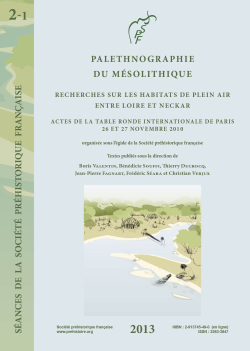
S2-07PDF - Sylvain Griselin, Caroline Hamon et Guy Boulay - Fabrication et utilisation des outils prismatiques de type montmorencien : l'exemple du 62 rue Henry-Farman à Paris (15e arrondissement)Le gisement mésolithique du 62 rue Henry-Farman à Paris (15e arrondissement), fouillé par lINRAP en 2008 a livré une série doutils prismatiques dont on peut étudier le mode de production, dentretien et dutilisation. Ces outils macrolithiques, présents sur des sites du Mésolithique moyen, sont très bien représentés en Île-de-France et à ses marges, ainsi que ponctuellement dans le reste du Bassin parisien. Sur le site de Paris, les pièces, généralement fragmentées, sont réalisées en grès-quartzite et mesurent une dizaine de centimètres de long pour les éléments entiers. Leur section transversale est triangulaire et / ou trapézoïdale. Lune des faces, plane et dépourvue de retouches, est caractéristique des outils de type montmorencien. Le façonnage apparait relativement simple, car il vise à mettre en forme les flancs et la partie dorsale des objets et à aménager les arêtes latérales longitudinales. Différents degrés de réfection sont observables sur les pièces et suggèrent une utilisation assez longue des outils. Ceux-ci portent des traces dusage au contact avec une matière minérale sur toute la longueur des arêtes longitudinales de la face plane et de la face opposée tandis quun autre type démoussé encore indéterminé affecte les plages en relief des flancs. Les arêtes constitueraient les principales surfaces actives de ces objets et, malgré un émoussé visible sur les extrémités de quelques exemplaires, cette disposition des traces réfuterait lusage principal comme « pic » qui a souvent été supposé. Dautres hypothèses fonctionnelles peuvent alors être formulées. Plusieurs tests préliminaires ont été réalisés pour les tester, incluant notamment lutilisation de ces outils comme retouchoirs pour fracturer des lamelles par la technique du microburin. Cette hypothèse est discutée à la lumière des traces dutilisation observées sur les outils archéologiques et expérimentaux.
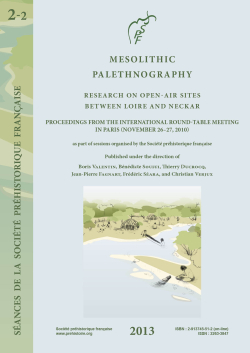
S2-08EN_PDF_Colas Guéret - Character and variability of Early Mesolithic toolkits in Belgium and Northern France: the contribution of a functional approachThe technological and typological study of Mesolithic domestic tools has often been hampered by their un-standardised nature. This study presents the results of a functional approach to three Early Mesolithic (Preboreal and Boreal periods) assemblages from Northern France and Belgium. Use-wear analysis has made it possible to identify different materials worked by Mesolithic groups, especially plants probably used in basketry and weaving. The examination of un-modified blanks sheds new light on the very significant use of the un-retouched pieces which dominate the toolkits. Furthermore, a more detailed analysis of different functional modes suggests that technical attitudes varied between different sites. Site functions, together with chronological and geographic differences were also factors likely to have played a role in the contrasts observed between sites. Functional studies, which are still too sporadic, undoubtedly have a part to play in untangling these factors.
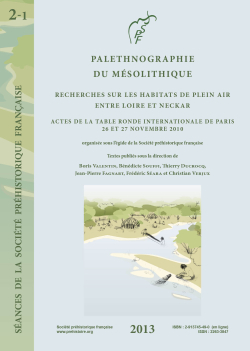
S2-08PDF - Colas Guéret - Identité et variabilité de l'outillage lithique du Premier Mésolithique en Belgique et dans le Nord de la France : les apports de l'approche fonctionnelleLétude de loutillage domestique mésolithique a souvent été desservie par son caractère peu standardisé, autant du point de vue typologique que technologique. Cette étude présente les résultats de lapproche fonctionnelle de trois assemblages du Premier Mésolithique de Belgique et du Nord de la France. Par la tracéologie, il a été possible didentifier les matières travaillées par les Mésolithiques, notamment des plantes probablement transformées pour la vannerie et la sparterie. Lobservation des supports bruts a permis de mettre en évidence une utilisation très importante de pièces non retouchées, majoritaires dans loutillage. Par ailleurs, lanalyse fine des modes de fonctionnement suggère des ambiances techniques variées entre les différents gisements. La fonction des sites ainsi que les différences chronologiques et géographiques sont autant de facteurs susceptibles de jouer un rôle dans ces contrastes. Les études fonctionnelles, encore trop ponctuelles, ont tout leur rôle à jouer pour démêler ces facteurs.
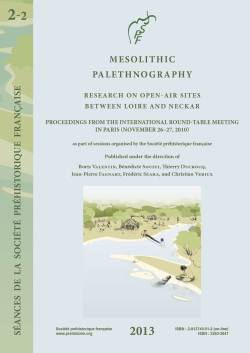
S2-09EN_PDF_Olivier Bignon-Lau, Paule Coudret, Jean-Pierre Fagnart and Bénédicte Souffi Preliminary data concerning the spatial organisationof Mesolithic remains from locus 295of Saleux (Somme): a faunal perspectiveLocus 295 from Saleux is one the best documented and preserved of the site. A Boreal peat covered the vestiges of this Mesolithic camp shortly after it was abandoned. Preservation conditions of the archaeological level and organic remains are thus ideal for reconstructing the space occupied by Mesolithic groups during the Boreal around 8500 BP (7550 calBC). The study of the spatial distribution of lithic artefacts, as well as several refits, compared with zooarchaeological analyses shed light on the internal organisation of space and the nature of the activities carried out on the site. Taken as a whole, this information suggests a relatively short occupation by a small human group whose main objective was the hunting of wild boar.
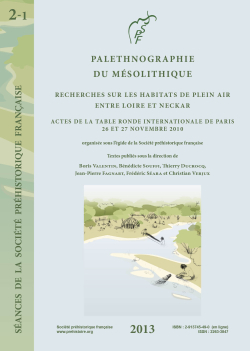
S2-09PDF - Olivier Bignon-Lau, Paule Coudret, Jean-Pierre Fagnart et Bénédicte Souffi - Données préliminaires sur l'organisation spatiale des vestiges mésolithiques du locus 295 du gisement de Saleux (Somme) : l'apport de la fauneLe locus 295 du gisement de Saleux constitue à ce jour loccupation mésolithique la mieux documentée et la mieux préservée du site. Une tourbe dâge boréale est venue recouvrir les vestiges du campement peu de temps après le départ des hommes. Les conditions de préservation du niveau archéologique et des témoins organiques sont donc favorables à une restitution optimale de lespace occupé par les Mésolithiques lors de la chronozone du Boréal, vers 8500 BP (7550 cal. BC). Létude de la répartition des artefacts lithiques et de quelques remontages confrontée aux analyses de larchéozoologie permet de préciser lorganisation interne de lespace occupé et de déterminer la nature des activités développées sur le site. Lensemble des données recueillies permet de proposer lhypothèse dune occupation relativement courte dans le temps par un petit groupe humain dont lobjectif principal repose sur la chasse du sanglier.
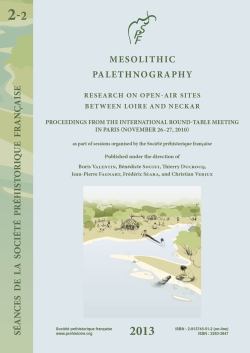
S2-10EN_PDF_Thierry Ducrocq - The Beuronian with crescents in Northern France: the beginnings of a palethnological approachThe establishment of a Mesolithic chrono-cultural framework reveals several successive traditions in Northern France. The most well-documented of which is the Beuronian with crescents dated to around 8,000 calBC. The main sites actually seem to represent the juxtaposition of contemporaneous concentrations. The time spent at these sites seems brief and principally concerns hunting activities focused on wild boar.
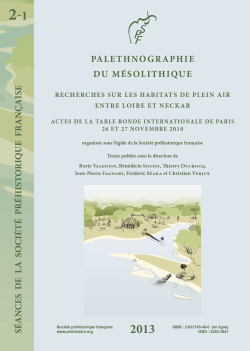
S2-10PDF - Thierry Ducrocq - Le Beuronien à segments dans le Nord de la France. Prémices d'une approche palethnologiqueLétablissement dun cadre chronoculturel pour le Mésolithique permet disoler plusieurs traditions successives en France septentrionale. La mieux documentée est le Beuronien à segments qui est datée aux environs de 8000 avant J.-C. Les principaux gisements seraient des juxtapositions de concentrations contemporaines. Les séjours semblent brefs et surtout consacrés aux activités cynégétiques avec une prédilection pour le sanglier.
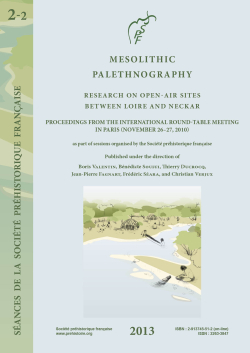
S2-11EN_PDF_Gabrielle Bosset and Frédérique Valentin Mesolithic burial practices in the northern half of France: isolated burials and their spatial organisationThirty-six Mesolithic graves, mainly primary inhumations of a single individual, were identified from 15 sites in the northern half of France. We present here a synthetic description of these graves which sheds light on the variety of funerary rites and practices. These graves are spread across the space occupied by these groups in two ways: grouped together or isolated. The chronological and spatial demarcation of 14 of these graves suggests that at least three of them represent a specific behaviour shared by certain Middle Mesolithic groups who occupied the Paris Basin.
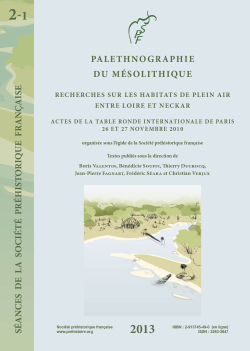
S2-11PDF -Gabrielle Bosset et Frédérique Valentin - Pratiques sépulcrales mésolithiques de la moitié nord de la France : le cas des sépultures isolées et leur intégration dans l'espaceTrente-six tombes mésolithiques, principalement des inhumations individuelles en dépôt primaire, ont été identifiées sur quinze sites de la moitié nord de la France. Leur description, présentée ici de façon synthétique, met en évidence la variété des gestes et pratiques funéraires. Ces tombes se répartissent dans lespace investi par les groupes selon deux modalités. Elles peuvent être groupées ou isolées. Notre analyse de lisolement chronologique et spatial de quatorze tombes permet de penser quau moins trois dentre elles témoignent dun comportement particulier de certains groupes ayant vécu dans le Bassin parisien au Mésolithique moyen.
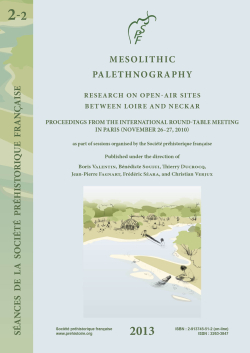
S2-12EN_PDF_Gunther Noens - Intrasite analysis of Early Mesolithic sites in Sandy Flanders: the case of Doel-‟Deurganckdok J/L, C3ˮLithic open-air sites situated in unstratified coversand deposits are our most important source of information for the study of the Early Mesolithic in the sandy lowlands of Northern Belgium. Their poor resolution in terms of both stratigraphic and organic preservations requires the development of adapted research designs in order to make reliable inferences regarding their complex formation processes. In this article, it is argued that an accurate reconstruction of these processes is possible by including systematic refitting into our intra- and intersite research programs. Some preliminary results of such an integrated intrasite approach, including radiometric and lithic analyses (i.e. morphotypology, attribute analysis, refitting, microwear) from the Early Mesolithic site of Doel-Deurganckdok J/L (C3) are presented to explore both the technological aspects of this lithic assemblage as well as the formation processes of this site.
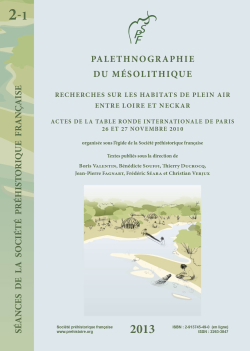
S2-12PDF - Gunther Noens - Analyse intra-site de gisements du Mésolithique ancien de la Flandre sableuse : l'exemple de Doel- « Deurganckdok J/L », C3Les gisements de plein air situés dans des dépôts de sables de couverture non stratifiés sont la source principale d'information pour le Mésolithique ancien des basses-terres sableuses de la Belgique du Nord. Leur faible qualité en termes de stratigraphie et de conservation des matériaux organiques nécessite la mise au point de projets de recherches adaptés afin den déduire des informations fiables concernant les processus complexes de formation de ces gisements. Dans cet article, nous soutenons que la reconstruction de ces processus est possible en intégrant les remontages systématiques dans nos programmes de recherches intra- et inter-sites. On présente quelques résultats préliminaires de lapproche intra-site du gisement mésolithique ancien de Doel-« Deurganckdok J/L » (C3), approche combinant des analyses radiométriques et lithiques (comme la morphotypologie, lanalyse dattributs, les remontages, la tracéologie) et permettant de discuter les caractères technologiques de cet assemblage lithique ainsi que les processus de formation de ce gisement.
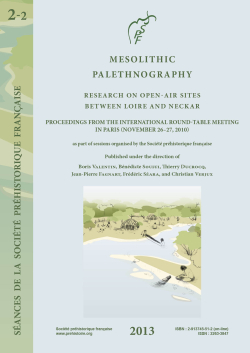
S2-13EN_PDF_Philippe Crombé, Joris Sergant and Jeroen De Reu The use of radiocarbon dates in unraveling Mesolithic palimpsests: examples from the coversand area of North-West BelgiumExtensive radiocarbon dating at several sealed sites in North-West Belgium has enabled investigation of the formation processes of spatial and cumulative palimpsests dating to different stages of the Mesolithic. A clear spatio-temporal difference could be observed in the occupation of large versus small sand dunes. The former are characterized by continuous occupation on a seasonal basis over many hundreds of years, mainly during the Early and Final Mesolithic, leading to either extensive spatial palimpsests (Early Mesolithic) or dense cumulative palimpsests (Final Mesolithic). The occupation of smaller sand dunes on the other hand seems more discontinuous but covering the entire Mesolithic and even the Early Neolithic. Furthermore a difference in the relative duration of each occupation stay is likely, with relatively longer stays on larger dunes and more ephemeral visits on smaller dunes.
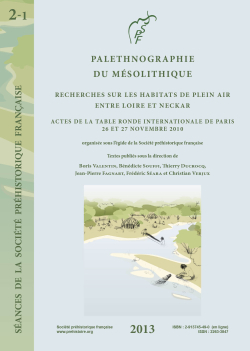
S2-13PDF -Philippe Crombé, Joris Sergant et Jeroen De Reu - La contribution des dates radiocarbone pour démêler les palimpsestes mésolithiques : exemples provenant de la région des sables de couverture en Belgique du Nord-OuestUne série importante de datations radiocarbone sur quelques sites enfouis dans le nord-ouest de la Belgique a permis danalyser la formation de palimpsestes cumulatifs et spatiaux datant des différentes phases du Mésolithique. On observe une nette différence spatio-temporelle entre les occupations des grandes dunes et celles des petites dunes. Les premières sont caractérisées par une occupation continue sur une base saisonnière pendant plusieurs centaines dannées, essentiellement durant le Mésolithique ancien et final, produisant des palimpsestes spatiaux étendus (Mésolithique ancien) ou des palimpsestes cumulatifs denses (Mésolithique final). Loccupation des petites dunes, quant à elle, semble plus discontinue couvrant tout le Mésolithique et même le Néolithique ancien. Par ailleurs, une différence entre la durée de séjour de chaque occupation est probable, avec des séjours plus longs pour les grandes dunes et des visites plus éphémères pour les petites dunes.
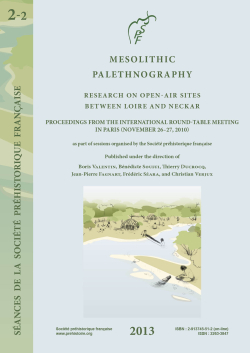
S2-14EN_PDF_Claus Joachim Kind - Tiny stones in the mud. The Mesolithic sites of Siebenlinden (Rottenburg, Baden-Württemberg, South West Germany)The Mesolithic sites of Siebenlinden were excavated between 1990 and 2004. Several areas were investigated which belong to a large Mesolithic landscape. The site of Siebenlinden 3-5 covers an area of about 480 m². Three Mesolithic layers were identified. The uppermost layer belongs to the Late Mesolithic while the two lower ones can be assigned to the Beuronian. The three different layers show different aspects. The uppermost layer II is the product of a residential camp which was occupied for a medium length of time of about one or two weeks. Layer III also clearly shows features of a residential camp site which seems to have been occupied for a longer period of several weeks. The internal organization of layer III differs remarkably from the organization of layer II. This may be due to a change in social behaviour. Finally, the smaller find concentrations in layer IV seem to represent brief field camps which were occupied during the acquisition of resources such as game and hazelnuts.
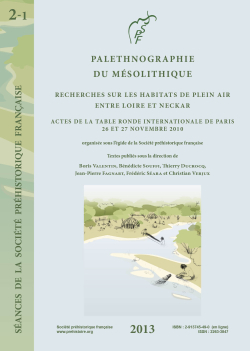
S2-14PDF - Claus Joachim Kind - De toutes petites pierres dans la boue. Les sites mésolithiques de Siebenlinden (Rottenburg, Baden-Württemberg, Allemagne du sud-ouest)Les sites mésolithiques de Siebenlinden ont été fouillés entre 1990 et 2004. Plusieurs emplacements appartenant à un vaste complexe mésolithique ont fait lobjet de recherches. Le site de Siebenlinden 3-5 sétend sur environ 480 m2. Trois couches mésolithiques ont pu y être identifiées. La couche sommitale est attribuable au Mésolithique final alors que les deux autres peuvent être attribuées au Beuronien. Ces trois couches présentent différents aspects. Au sommet, la couche II correspond à un campement résidentiel qui a été fréquenté pour une période de durée moyenne denviron une ou deux semaines. La couche III présente également les traits dun campement résidentiel qui semble avoir été occupé pendant une période plus longue de lordre de plusieurs semaines. Lorganisation interne de la couche III diffère remarquablement de lorganisation de la couche II, ce qui est probablement lié à un changement de comportement social. Enfin, les plus petites concentrations de mobilier dans la couche IV semblent représenter des haltes de courte durée, occupées durant les périodes dacquisition de certaines ressources comme le gibier ou les noisettes.
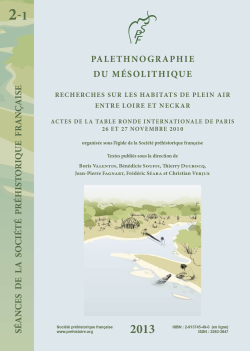
S2-completPDF - PALETHNOGRAPHIE DU MÉSOLITHIQUE RECHERCHES SUR LES HABITATS DE PLEIN AIR ENTRE LOIRE ET NECKAR Actes de la table ronde internationale de Paris, 26 et 27 novembre 2010« Palethnographie du Mésolithique » : le titre de cet ouvrage est une sorte de pétition de principe, à la fois théorique et méthodologique. Une façon de dire que les recherches sur les derniers chasseurs-collecteurs ont aujourdhui grand besoin de ce genre déclairage. Or,depuis les années 1990, une moisson spectaculaire dhabitats de plein air,parfois vastes, a eu lieu : cest un des apports notables de larchéologie préventive. Quelques programmes de fouille de plus longue haleine alimentent également cette base de connaissances exponentielle, intégrant de plus en plus de gisements assez bien préservés pour que lexigence palethnographique commence à sy déployer. Cet ouvrage ne marquant quune étape dans ce mouvement de fond rénovant les recherches sur le Mésolithique, on sest limité à la moitié septentrionale de la France et à quelques régions limitrophes, en se concentrant sur les occupations du VIIIe millénaire avant J.-C., pour linstant les mieux connues. La première partie contient quelques esquisses de monographies dessinant tout un potentiel détudes pour lavenir, et aussi quelques régularités en termes de structuration, voire dimplantation. Ces découvertes, complétées par dautres, alimentent ensuite le second volet de louvrage consacré aux résultats que lon commence à réunir sur le fonctionnement des campements.
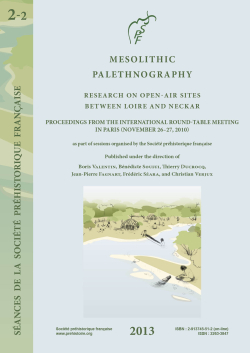
S2_EN_complete - MESOLITHIC PALETHNOGRAPHY RESEARCH ON OPEN-AIR SITES BETWEEN LOIRE AND NECKAR Proceedings from the international round-table meeting in Paris (November 2627, 2010)Mesolithic Palethnography : part of this volumes title represents a sort of methodological and theoretical mission statement designed to convey the idea that research concerning the last hunter-collectors is today in desperate need of this type of insight. Since the beginning of the 1990s, a spectacular crop of occasionally vast open-air sites has emerged, one of the notable contributions of preventive archaeology. Several long-term excavations have also added to this exponentially increasing body of information that has now come to include a growing number of well-preserved sites that have allowed us to address palethnographic questions. This volume represents a first step towards revitalising Mesolithic research. Here we have focused on occupations from the 8th millennium cal BC, currently the best documented periods, and limited the scope to Northern France and certain neighbouring regions. The first part contains several preludes to monographs highlighting potential future studies as well as various patterns in the structuring of space and the location of camps. These, as well as other complementary discoveries, provide material for the second part of the volume dedicated to new data concerning the functional dynamics of Mesolithic camps.
![[ACCES LIBRE] - SÉANCE 13 - « à coup d'éclats ! » La fracturation des matières osseuses en préhistoire : discussion autour d'une modalité d'exploitation en apparence simple et pourtant mal connue](https://www.prehistoire.org/offres/file_inline_src/515/515_imgM_170119_113714.jpg)
[ACCES LIBRE] - SÉANCE 13 - « à coup d'éclats ! » La fracturation des matières osseuses en préhistoire : discussion autour d'une modalité d'exploitation en apparence simple et pourtant mal connue
« à coup d'éclats ! »La fracturation des matières osseuses en préhistoire : discussion autour d'une modalité d'exploitation en apparence simple et pourtant mal connue
Actes de la séance de la Société préhistorique française de Paris (25 avril 2017)
Textes publiés sous la direction de Marianne Christensen et Nejma Goutas
Paris, Société préhistorique française, 2018 (Séances de la Société préhistorique française, 13), 367 p.
www.prehistoire.org
ISSN : 2263-3847 - ISBN : 2-913745-74-1 (en ligne)
ACCÉDEZ GRATUITEMENT A L'ENSEMBLE DES ARTICLES
La fracturation lato sensu des matières osseuses désigne différentes réalités, selon les disciplines concernées (archéozoologie, technologie, anthropologie physique), mais aussi selon les contextes historiques et scientifiques dans lesquels ce concept est utilisé, les matières premières auxquelles il est appliqué, ou encore ses objectifs. Devant cette multiplicité des points de vue, se sont développées certaines incohérences méthodologiques, terminologiques et scientifiques. Il devenait donc essentiel de produire un regard critique sur cette polysémie du concept de fracturation des matières osseuses, car ses conséquences dépassent largement le seul champ épistémologique et influencent parfois directement certains modèles interprétatifs des faits préhistoriques. Ce volume a un objectif à la fois historiographique, à travers un état de l'art des recherches relatives à la transformation des matières osseuses par fracturation et les techniques de fracture utilisées, mais aussi méthodologique, via une (ré-)évaluation de certains critères analytiques et de diagnoses employés pour discriminer les différentes modalités de transformation des matières dures d'origine animale faisant intervenir des actions de percussion. Enfin, ce volume rassemble une dizaine de textes autour de l'exploitation du bois de cervidé, de l'os, de l'ivoire, de la coquille et du bois végétal, à partir de cas d'étude issus de contextes aussi variés que le Paléo-mésolithique d'Europe occidentale et orientale, ou l'Holocène de l'extrême sud de l'Amérique du Sud.
Fracturing lato sensu of osseous materials can have different meanings depending on the field involved (zooarchaeology, technology, anthropology) as well as according to the historical and scientific context in which this concept is used, the raw materials to which it is applied, or the objectives that were pursued. These various points of view led to the development of methodological, terminological or scientific inconsistencies. It therefore became essential to take a critical look at the polysemous concept of the fracturing of osseous materials, because its consequences extend well beyond the epistemological sphere and sometimes directly impact interpretative models of prehistoric social realities. This volume pursues a twofold objective: a historiographical one???through state-of-the-art of research carried out on the transformation of osseous materials by fracturing and the fracturing techniques used; and a methodological one???through the revision of distinct analytical criteria and diagnostics used to differentiate between the modalities of transformation related to hard animal materials by using percussion. Lastly, this volume groups together a dozen contributions dealing with the exploitation of cervid antler, bone, ivory, shells, and wood based on case studies from a variety of contexts such as the Palaeolithic and Mesolithic in western and eastern Europe or the Holocene period in the southern tip of South America.
![[ACCES LIBRE] - Séance 14 - Entre terres et eaux. Les sites littoraux de l'âge du Bronze : spécificités et relations avec l'arrière-pays](https://www.prehistoire.org/offres/file_inline_src/515/515_imgM_090320_142227.jpg)
[ACCES LIBRE] - Séance 14 - Entre terres et eaux. Les sites littoraux de l'âge du Bronze : spécificités et relations avec l'arrière-pays
Entre terres et eaux
Les sites littoraux de l'âge du Bronze : spécificités et relations avec l'arrière-pays
Actes de la Séance de la Société préhistorique française (Agde, 20-21 octobre 2017)
Textes publiés sous la direction d'Yves Billaud et Thibault Lachenal
Paris, Société préhistorique française, 2019
(Séances de la Société préhistorique française, 14), 376 p.
www.prehistoire.org
ISBN : 2-913745-76-8 (en ligne) - ISSN : 2263-3847
ACCÉDEZ GRATUITEMENT A L'ENSEMBLE DES ARTICLES
Les littoraux - rives de lacs, lagunes, fleuves, mais aussi estuaires et franges côtières - ont constitué des milieux particulièrement attractifs pour les sociétés de l'âge du Bronze d'Europe occidentale, bien que leur occupation a rarement été continue. En dépit de leur réputée insalubrité, ces environnements constituent des niches écologiques attractives, à l'interface de milieux complémentaires, offrant en cela des potentiels économiques variés. Les spécificités des témoins archéologiques d'occupations en milieux humides ou actuellement immergés, dans leurs techniques de fouilles comme dans la nature des vestiges qu'elles livrent, tendent à faire de leur étude une discipline à part, ne favorisant pas leur confrontation avec les sites « terrestres ». L'objectif de ce colloque, qui s'est tenu du 20-21 octobre 2017 à Agde, était donc de réunir des approches portant sur différents types de sites implantés dans ces zones d'interface entre la terre et l?eau, de réfléchir sur leurs spécificités et sur les relations qu'ils entretiennent avec les autres occupations localisées dans l'« hinterland » ou arrière-pays. Le présent ouvrage regroupe dix-sept contributions explorant cinq aires géographiques distinctes, présentant chacune leurs particularités orographiques et hydrographiques, mais qui se rejoignent sur des problématiques communes.
The shorelines of lakes, lagoons, rivers as well as estuaries and coastal fringes - were particularly attractive to the Bronze Age communities of Western Europe, although they do not seem to have been occupied continually. Despite their reputation for being unhealthy, these environments are attractive ecological niches at the interface of complementary environments, offering a great economic potential. The specificities of these wetland or submerged sites, from the excavation techniques to the structures and the materials unearthed, come together in a totally separate discipline, which does not encourage direct comparison with "terrestrial" sites. The aim of this symposium, which was held on 20-21 October 2017 in Agde, was therefore to bring together different approaches to the study of sites located in these interface zones between land and water, to reflect on their specificities and their relationship with other occupations situated in the hinterland. This book includes seventeen contributions exploring five distinct geographical areas, each with their own specific orographic and hydrographic characteristics, but which are linked on common issues.
![[ACCES LIBRE] SÉANCE 12 - Creuser au Mésolithique / Digging in the Mesolithic](https://www.prehistoire.org/offres/file_inline_src/515/515_imgM_271117_155005.jpg)
[ACCES LIBRE] SÉANCE 12 - Creuser au Mésolithique / Digging in the Mesolithic
Creuser au Mésolithique
Digging in the Mesolithic
Actes de la séance de la Société préhistorique française
de Châlons-en-Champagne (29-30 mars 2016)
Textes publiés sous la direction de
Nathalie Achard-Corompt, Emmanuel Ghesquière et Vincent Riquier
Paris, Société préhistorique française, 2017
(Séances de la Société préhistorique française, 12)
www.prehistoire.org
ISSN : 2263-3847 ISBN : 2-913745-2-913745-73-3
ACCÉDEZ GRATUITEMENT A L'ENSEMBLE DES ARTICLES
Longtemps jugées inaptes à creuser des trous dans le sol, les populations mésolithiques ont été explorées au travers du seul prisme de sociétés nomades rythmées par lévolution de leurs industries lithiques. En France, la mise en évidence de loccupation mésolithique sur le site du « Parc du Château » à Auneau (Eure-et-Loir) au début des années 1990 par C. Verjux a marqué un véritable renouveau dans la recherche française, en rapprochant le territoire français de ceux des pays nordiques et des îles Britanniques, où cette connaissance était acquise. Elle a proposé une vision renouvelée des sociétés mésolithiques en guidant létude des structures en creux. Lentement mais sûrement, à la faveur des opérations darchéologie préventive, plusieurs régions ont vu ainsi émerger de nouveaux gisements de fosses. Dun type proche de celles dAuneau et de certains sites fouillés plus anciennement en Île-de-France ou en Picardie, ces fosses sen distinguent par une quasi-absence de restes matériels ou dautres vestiges qui trahiraient des aires dhabitat. Malgré ces avancées, dans lesprit de nombreux archéologues de terrain, et pour de multiples motifs, le Mésolithique demeure une longue période où les populations humaines ont eu un ancrage au sol très limité voire inexistant, la question de structure en creux restant incongrue, pour le moins exceptionnelle.
Introduit par Frédéric Séara, Anne Augereau et Jean-Paul Demoule, ce volume rassemble vingt-deux contributions visant à faire le point sur les découvertes de vestiges en creux mésolithiques, en France comme dans dautres pays voisins (Pays-Bas, Grande-Bretagne, Allemagne) ou plus lointains (Japon). Par le biais de présentations denvergure géographique variable, de dimension monographique ou plus synthétique, mais sappuyant toujours sur un socle détudes pluridisciplinaires, il brosse un panorama le plus complet des types des vestiges connus à ce jour dans lOuest de lEurope. Pour conclure sur une note en contrepoint, lextraordinaire richesse, en termes de vestiges en creux, de la culture Jômon qui fleurit au Japon durant plusieurs millénaires montre à quoi pourrait ressembler la carte mésolithique de lEurope.
Long considered incapable of digging holes in the ground, Mesolithic populations have until recently been examined solely through the lens of nomadic societies governed by the evolution of their lithic industries. In France, the discovery by C. Verjux of evidence for Mesolithic occupation at Parc du Chateau, Auneau (Eure-et-Loir), in the early 1990s marked a veritable turning point in French research, bringing France into line with the Scandinavian countries and the British Isles where such knowledge was already well established. It offered a new vision of Mesolithic societies through the study of pit features. Slowly but surely, particularly through rescue excavations, many regions have revealed hitherto unknown pit complexes. Of a type similar to those found at Auneau and sites previously excavated in Île-de-France and Picardy, these pits are characterized by the virtual absence of material remains or other remains that might indicate areas of habitation. Despite these advances, and for many reasons, many field archaeologists continue to view the Mesolithic as a long period during which human populations had a very limited or non-existent tie to the land, a context in which the existence of pits is seen as incompatible or, at most, a rare occurrence.
Introduced by Frédéric Séara, Anne Augereau and Jean-Paul Demoule, this volume brings together twenty-two contributions that aim to take stock of recent discoveries of Mesolithic pits in France, neighbouring countries (The Netherlands, Great Britain, Germany) and further afield (Japan). Through presentations of various geographical scales, and varying in scope from monographs to syntheses, but always based on multi-disciplinary studies, this publication paints a more complete picture of the types of pits known to date in Western Europe. To conclude on a counterpoint, the extraordinary richness of the pit remains of the Jômon Culture in Japan, which flourished for several millennia, shows what the map of Mesolithic Europe might look like one day.
![[ACCES LIBRE] Séance 8 Lessor du Magdalénien Aspects culturels, symboliques et techniques des faciès à Navettes et à Lussac-Angles](https://www.prehistoire.org/offres/file_inline_src/515/515_imgM_290317_112739.jpg)
[ACCES LIBRE] Séance 8 Lessor du Magdalénien Aspects culturels, symboliques et techniques des faciès à Navettes et à Lussac-Angles
"Lessor du Magdalénien
Aspects culturels, symboliques et techniques des faciès à Navettes et à Lussac-Angles"
Actes de la séance de la Société Préhistorique Française de Besançon, 17-19 octobre 2013
Textes publiés sous la direction de Camille Bourdier, Lucie Chehmana, Romain Malgarini et Marta Połtowicz-Bobak
Paris, Société préhistorique française, 2017,
ISBN : 2-913745-67-9 [en ligne], 254 p.
ACCÉDEZ GRATUITEMENT A L'ENSEMBLE DES ARTICLES
La séance de la Société préhistorique française organisée en 2013 à Besançon fut consacrée aux débuts du Magdalénien moyen (19000-17000 cal. BP), période contemporaine dimportants changements climatiques (fin du Dernier Maximum Glaciaire, événement de Heinrich 1) et marquée au sein du registre matériel par de multiples évolutions tant techniques et économiques que symboliques. La thématique en fut les faciès à navettes et à pointes de Lussac-Angles, intimement liés dans leur reconnaissance, et dont la réalité archéologique, les attributs et les relations spatiotemporelles furent en cette occasion redébattus. Cette publication offre lopportunité dun bilan réactualisé à la faveur du considérable renouvellement des données issues des vingt dernières années de recherche interdisciplinaire menées en France et à létranger (Allemagne, Pologne) sur ces faciès. Fondé sur des collaborations croisées, mêlant productions technoéconomiques (industrie lithique, industrie osseuse) et symboliques (parure, art pariétal, art mobilier), cet ouvrage livrera au lecteur une caractérisation affinée, nuancée sur certains aspects, de ces sociétés humaines ainsi que les premiers éléments pour une recherche paléogéographique désormais à conduire.
The Séance de la Société Préhistorique Française held in 2013 in Besançon was dedicated to the beginnings of the Middle Magdalenian (19000-17000 cal. BP), contemporary of major climatic changes (end of the Last Glacial Maximum, Heinrich 1 event) and characterized by multiple technical, economical or symbolic transformations. Closely related in their identification and definition, the facies with navettes and the facies with Lussac-Angles points were central point of these two days. What is their archaeological reality? What are their spatial and chronological relations? This publication gives the opportunity of an updated assessment provided by the last twenty years of interdisciplinary research in and outside France (Germany, Poland). Symbolic (rock and mobile art, personal adornment) and techno-economic (lithic and bone industry) sets of data are questioned in the 12 contributions put together in theses proceedings. This cross-disciplinary approach offers a refined characterization of our understanding of these societies as well as the first elements for a paleogeographic upcoming research.
![[ACCES LIBRE] SÉANCE 9 - Nouvelles données sur les débuts du Néolithique à Chypre New data on the beginnings of the Neolithic in Cyprus](https://www.prehistoire.org/offres/file_inline_src/515/515_imgM_020517_101040.jpg)
[ACCES LIBRE] SÉANCE 9 - Nouvelles données sur les débuts du Néolithique à Chypre New data on the beginnings of the Neolithic in Cyprus
Nouvelles données sur les débuts du Néolithique à Chypre
New data on the beginnings of the Neolithic in Cyprus
Actes de la séance de la Société préhistorique française
Paris, 18-19 mars 2015
Textes publiés sous la direction de
Jean-Denis Vigne, François Briois et Margareta Tengberg
Paris, Société préhistorique française, 2017
(Séances de la Société préhistorique française, 9), 251 p
www.prehistoire.org
ISSN : 2263-3847 -ISBN : 2-913745-69-5 [en ligne]
ACCÉDEZ GRATUITEMENT A L'ENSEMBLE DES ARTICLES
La néolithisation de Chypre fut longtemps considérée comme tardive (env. 7000 av. n.-è.) et génératrice de cultures marquées par l'insularité (Khirokitia, Sotira). Les découvertes des années 1990 et 2000, notamment à Shillourokambos, ont bouleversé cette conception, reculant de 15 siècles le début du Néolithique chypriote (8300 av. n.-è.) et faisant de cette phase ancienne une variante régionale, nommée Cypro-PPNB, du Néolithique précéramique B du proche continent. Les fouilles de ces cinq à six dernières années à Klimonas et Asprokremnos ont encore profondément modifié la donne : dès 9000 av. n.-è., soit 5 à 7 siècles plus tôt, Chypre était déjà peuplée par des groupes d'agriculteurs-chasseurs très semblables de ceux du PPNA levantin. Comme ces derniers, ils habitaient des villages dotés d'un grand bâtiment communautaire circulaire et semi-enterré. Dans le même temps, des découvertes tout aussi inattendues amenaient à réviser en profondeur le schéma évolutif du célèbre village de Khirokitia, et offraient une remarquable opportunité de discuter les effets des changements climatiques et environnementaux sur l'évolution d'un tissu villageois, autour de l'événement 6.2 kyr. Introduit par Jean Guilaine, professeur honoraire au Collège de France, le présent volume regroupe 14 contributions présentant les derniers résultats des trois missions (deux françaises et une britannique) responsables des plus récentes de ces avancées à Klimonas, Asprokremnos, Shillourokambos et Khirokitia. Elles résultent, bien sûr, des travaux de terrain menés depuis 2005, pour lesquels on trouvera ici la mise à jour la plus récente. Elles relatent aussi les résultats des analyses technologiques (outils de pierre taillée, macro-outillage, vaisselle de pierre, parure), archéozoologiques, archéobotaniques, géophysiques et géomorphologiques. La moitié des articles porte sur Klimonas, offrant pour la première fois une vision détaillée de ce remarquable site Cypro-PPNA. Tous les travaux présentés dans ce volume par les missions françaises ont été initiés dans le cadre du projet « Limassol » (Site d'Etude en Ecologie Globale, CNRS-MNHN-INRAP) et beaucoup sont signés par de jeunes docteurs ou des post-doctorants.
The Neolithic in Cyprus has long been considered to have started late (c. 7000 BC) and to have generated markedly insular cultures (Khirokitia, Sotira). However, discoveries during the 1990s and 2000s, especially at Shillourokambos, have deeply changed this conception; moving the beginning of the Cyprus Neolithic fifteen centuries earlier (8300 BC), and assimilating this early phase, the Cypro-PPNB, to a regional variant of the Pre-Pottery Neolithic B of the near continent. In addition, excavations conducted during the last five to six years at Klimonas and at Asprokremnos, have highlighted new information: from 9000 BC, five to seven centuries earlier, Cyprus was already inhabited by groups of hunter-cultivators, very similar to those of the Levantine PPNA. Comparably, they lived in villages with a large circular and semi-embedded communal building. At the same time, equally unexpected discoveries prompted us to revisit the famous village of Khirokitia, which provided great opportunities to discuss the effects of climate and environmental changes on the evolution of the village???s organization around 6.2 thousand year ago. Introduced by Jean Guilaine, Honorary Professor at the College de France, this volume groups together 14 contributions presenting the latest results of the three excavations (two French, one British) which produced these advances at Klimonas, Asprokremnos, Shillourokambos and Khirokitia. These result from the field observations made since 2005, for which the latest updates can be found here. They also relate the results of the technological (chipped stone tools, macro-tools, stone ware and ornaments), archaeozoological, archaeobotanical, geophysical and geomorphological analysis. Half of the articles deal with Klimonas and offer for the first time a detailed vision of this remarkable Cypro-PPNA site. All works presented in this volume by French excavations were initiated in the framework of the 'Limassol'program (Global Ecology Study Site, CNRS-MNHN-INRAP) and many were written by young PhDs or post-docs.
Coordonnées
Pôle éditorial de la MSH Mondes
(Maison de l'archéologie et de l'éthnologie)
Boite 41
21 allée de l'Université
F-92023 Nanterre cedex - FRANCE
Société préhistorique française
- La SPF
- Réunions
- Le Bulletin de la SPF
- Accès libre Jstor (1978-2023)
- Accès libre Persée (1904-2021)
- Bulletin de la SPF 2025, tome 122
- Bulletin de la SPF 2024, tome 121
- Bulletin de la SPF 2023, tome 120
- Bulletin de la SPF 2022, tome 119
- Organisation et comité de rédaction
- Comité de lecture (2020-2025)
- Ligne éditoriale et consignes BSPF
- Données supplémentaires
- Annoncer
- Publications
- Catalogue général (en pdf)
- Séances de la SPF (suppléments)
- Mémoires de la SPF
- Congrès Préhistoriques de France
- Travaux de la SPF
- Cahiers OS
- Typologie des objets de l'Age du Bronze en France
- Journées INTERNEO
- Hors collections
- Hors collection en accès libre
- Publier un ouvrage avec la SPF
- Règles de diffusion des non périodiques
- Newsletter
- Boutique
Powered by aiw-pro | all-in-web © 2026 | Simplifiez-vous la vie!
Chargement de la page : 570 ms

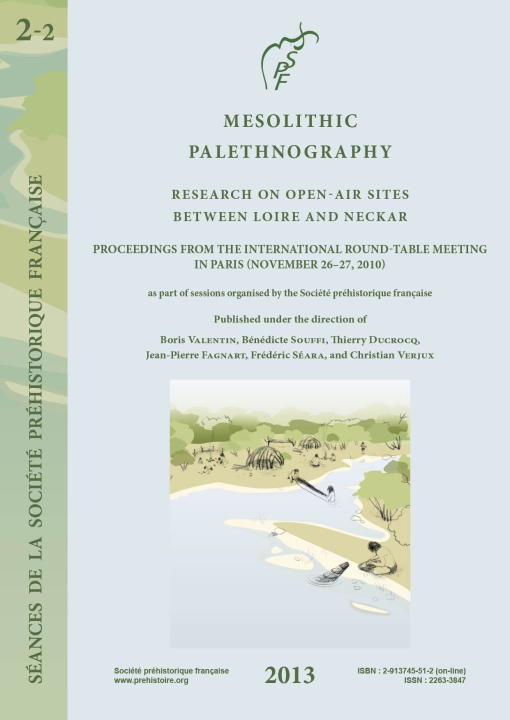
![[Accès libre] S20 (2023) - Dynamiques culturelles et transformation des paysages dans un continent en mutation : du Big Dry à lHolocène dans l'Est africain](https://www.prehistoire.org/offres/file_inline_src/515/515_imgM_151123_142921.jpg)
![[Accès libre] S21 (2025) - ÉMILE RIVIÈRE (1835-1922) EN QUESTIONS](https://www.prehistoire.org/offres/file_inline_src/515/515_imgM_230625_162541.jpg)

